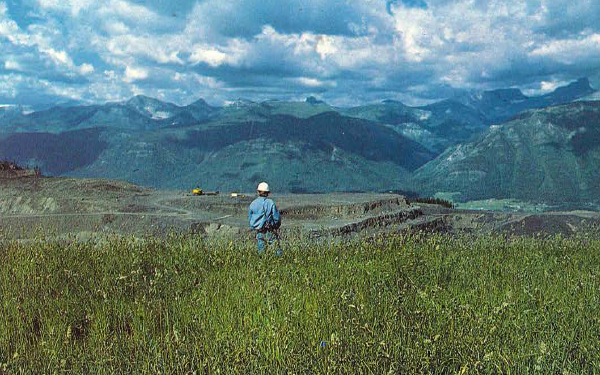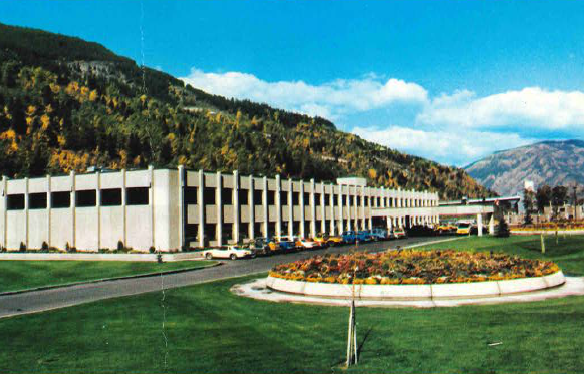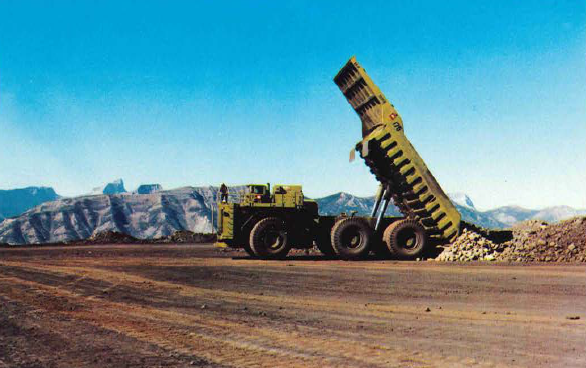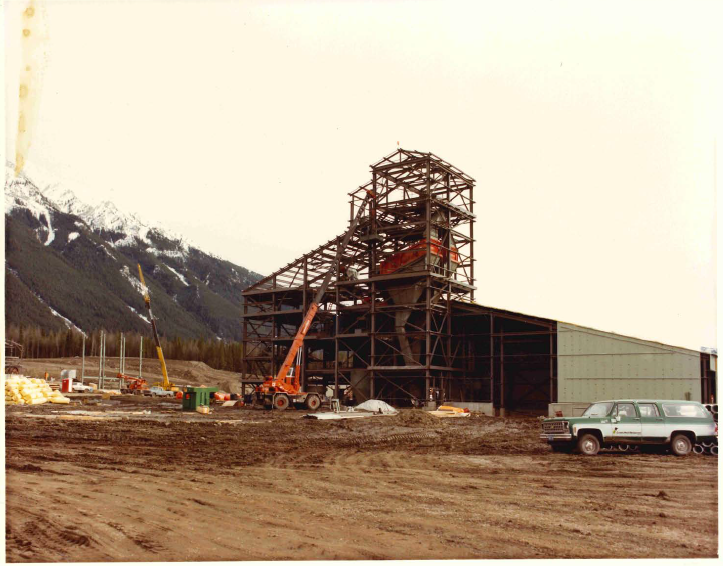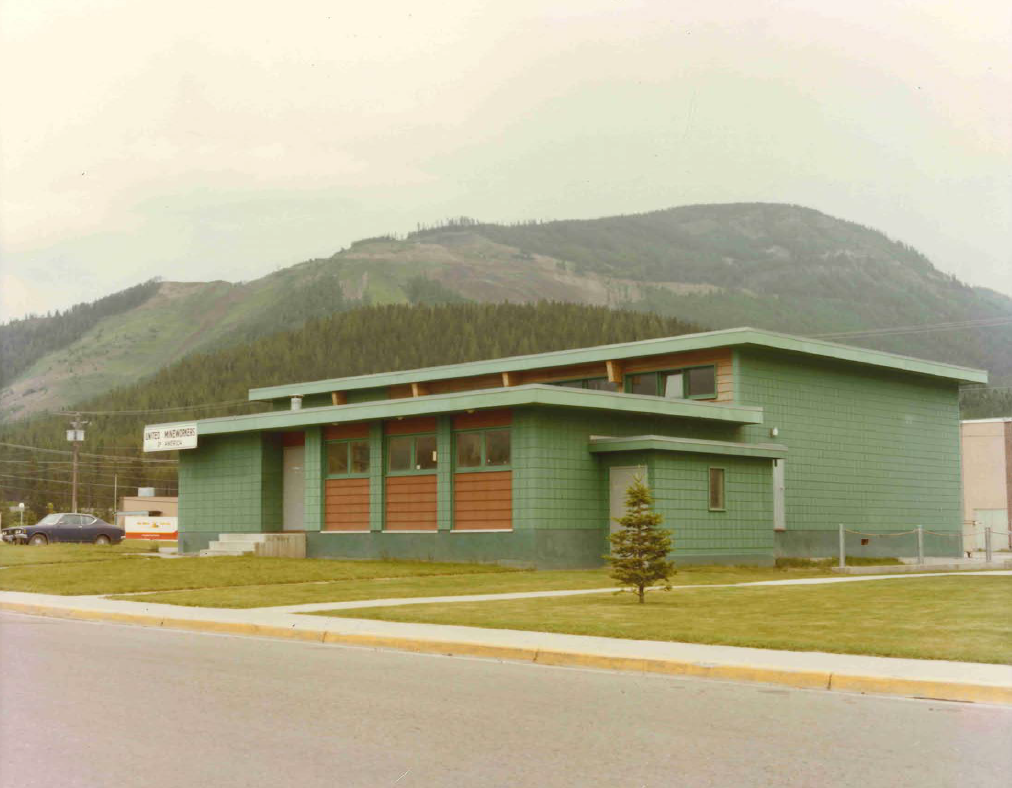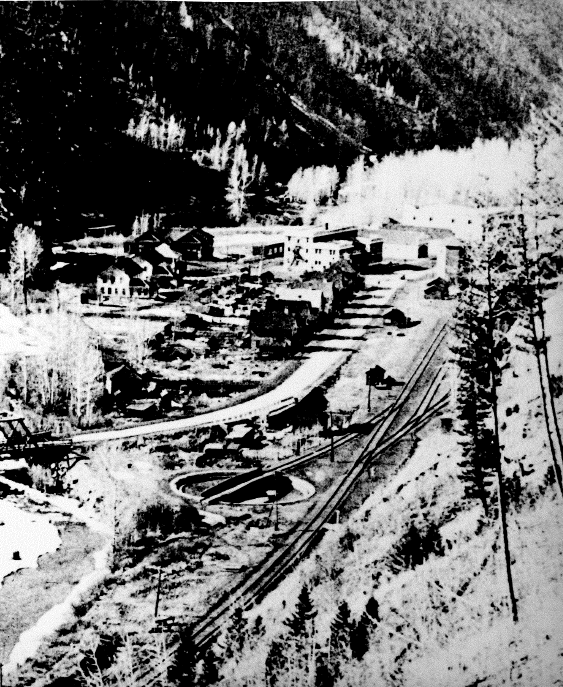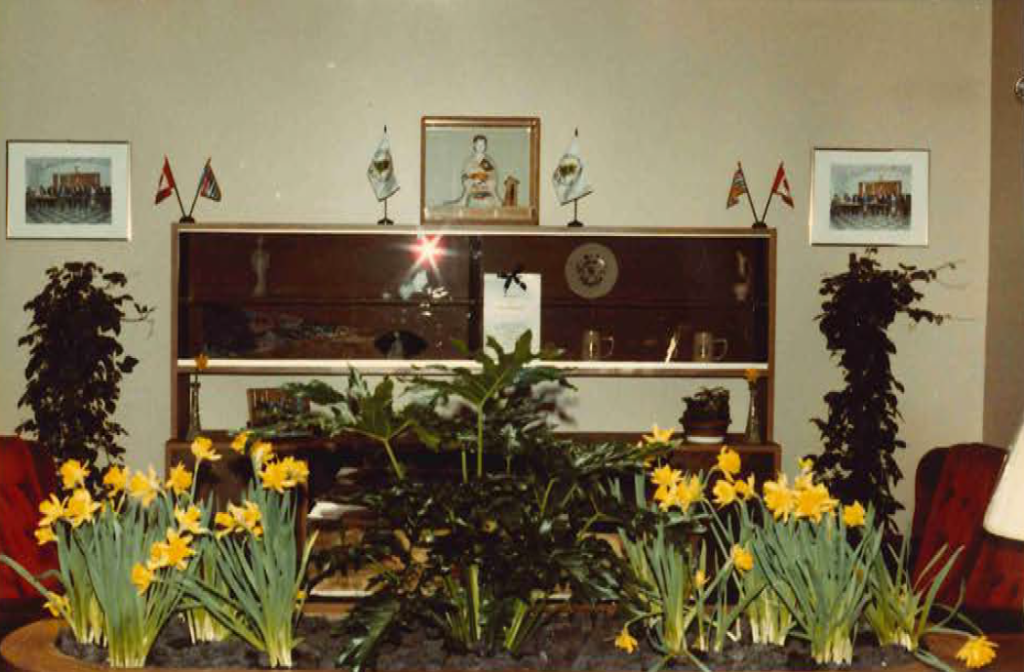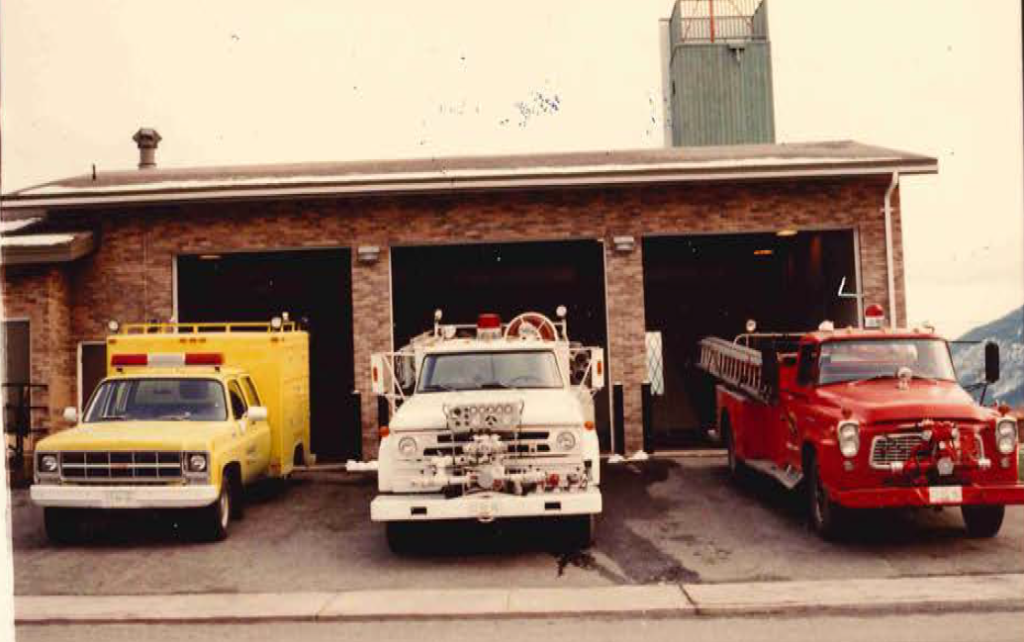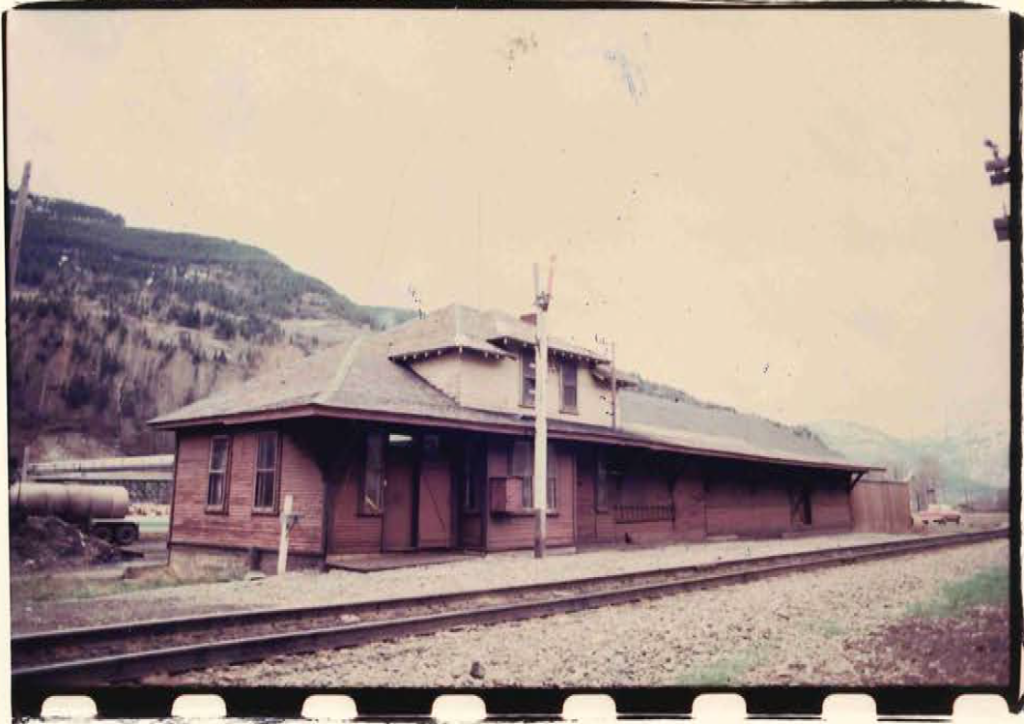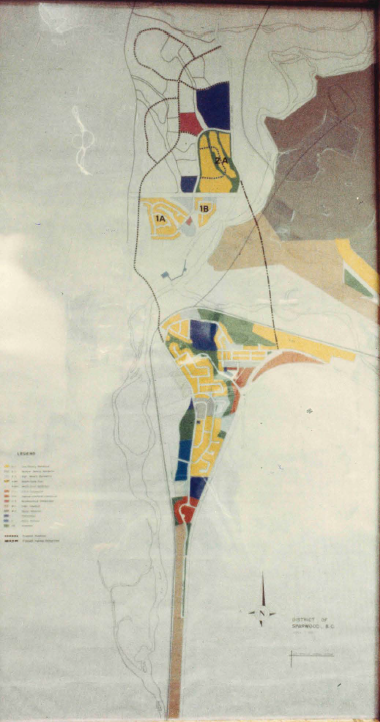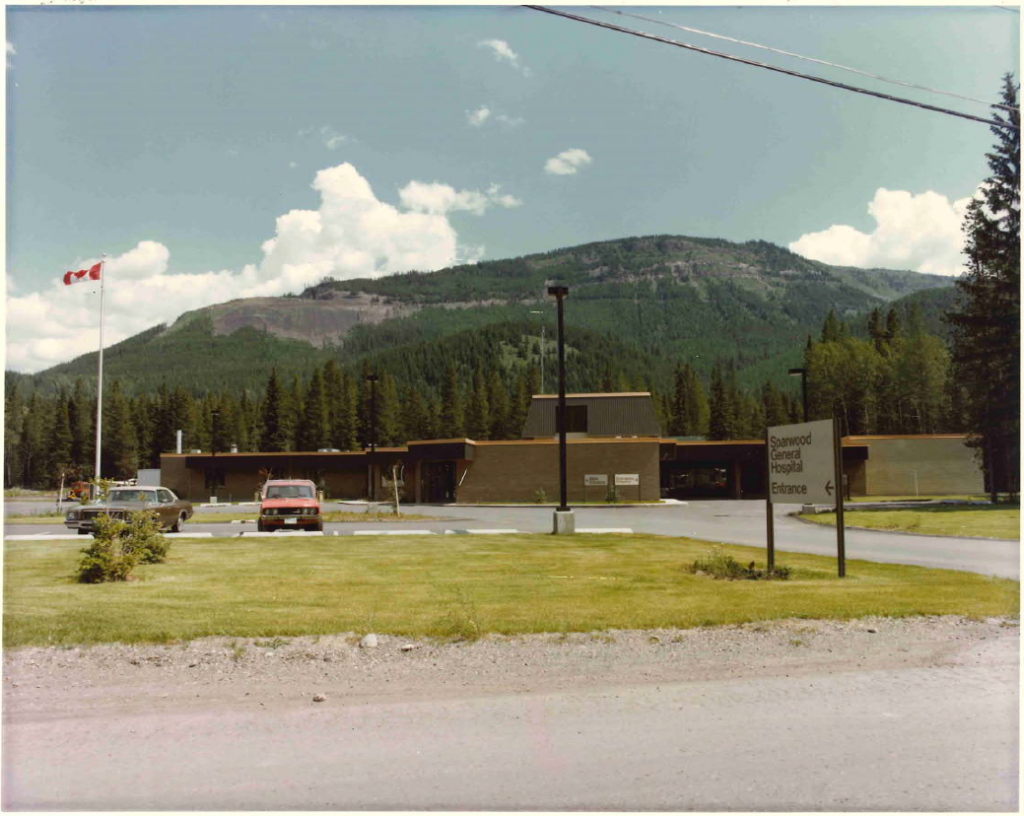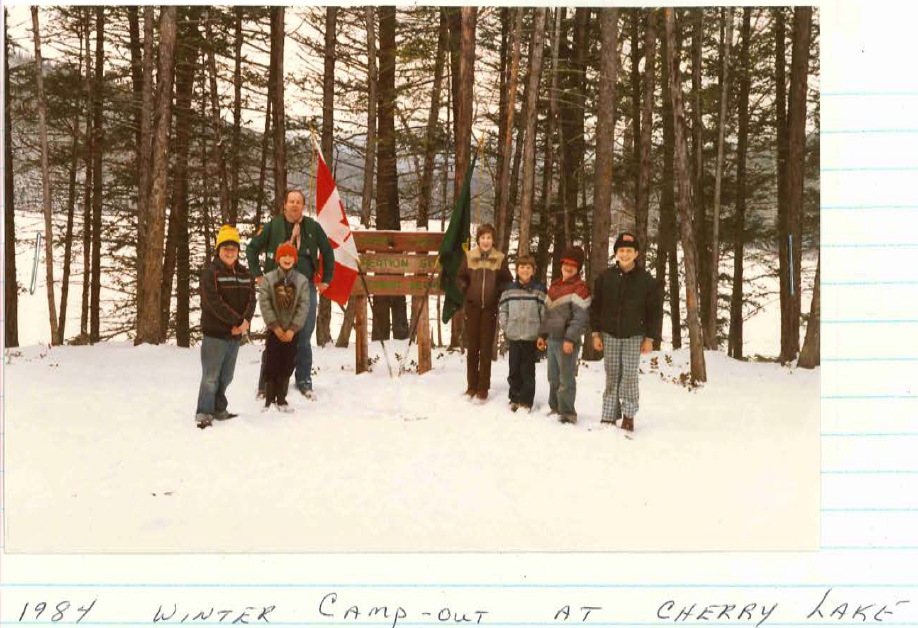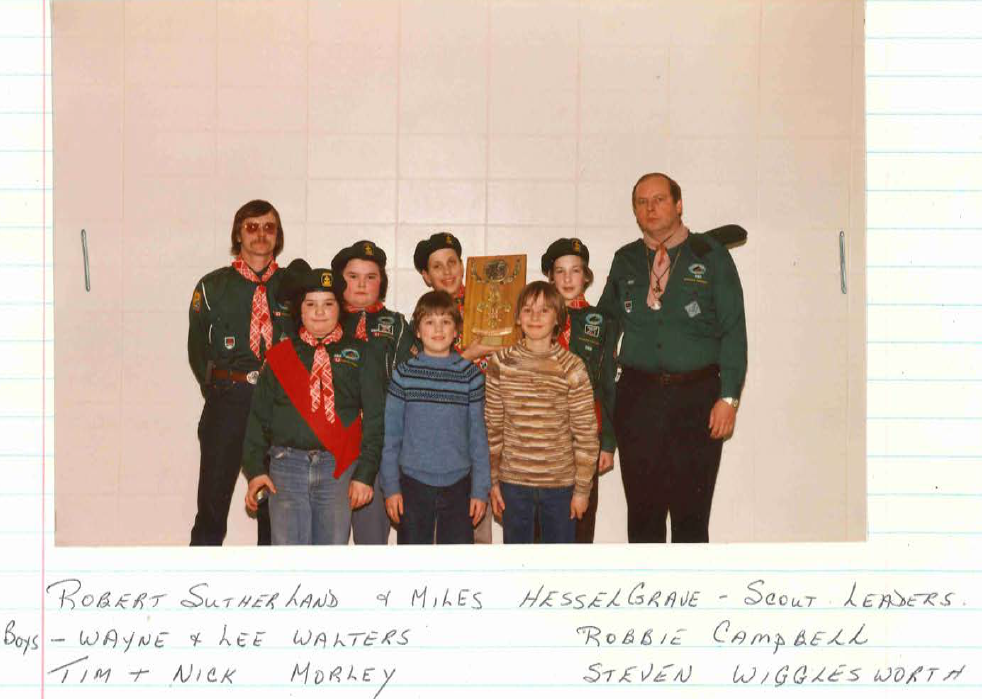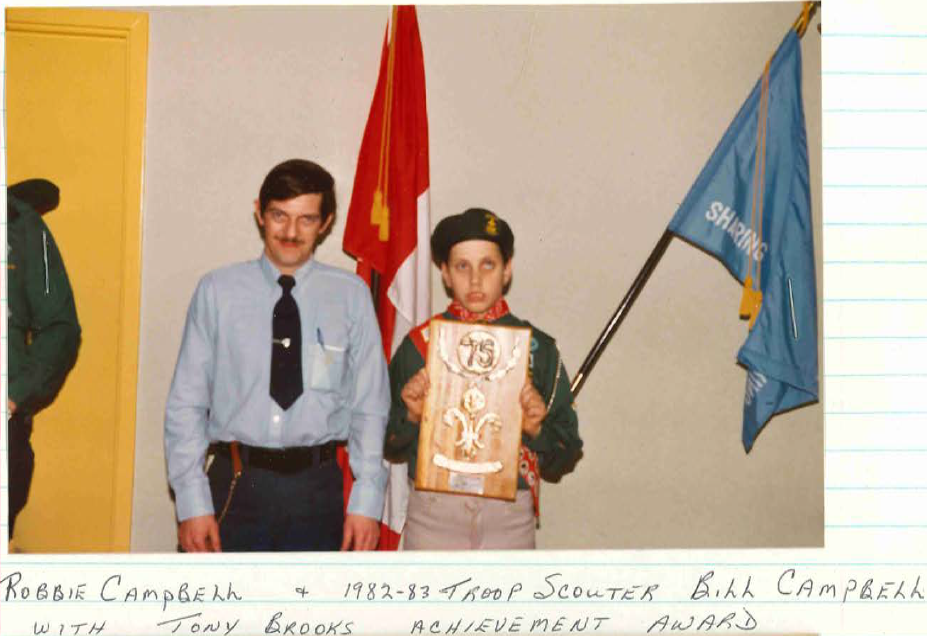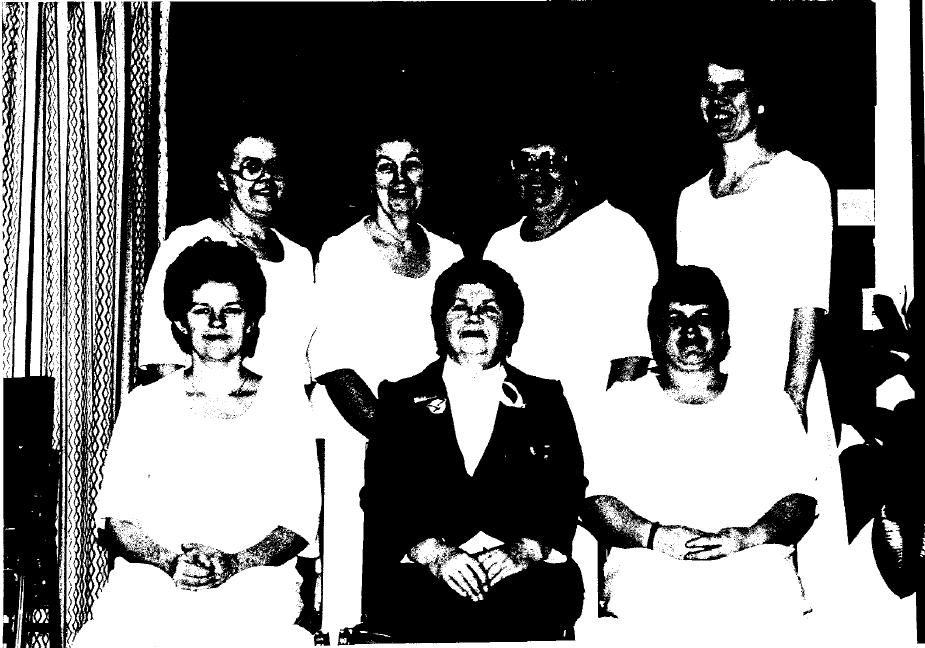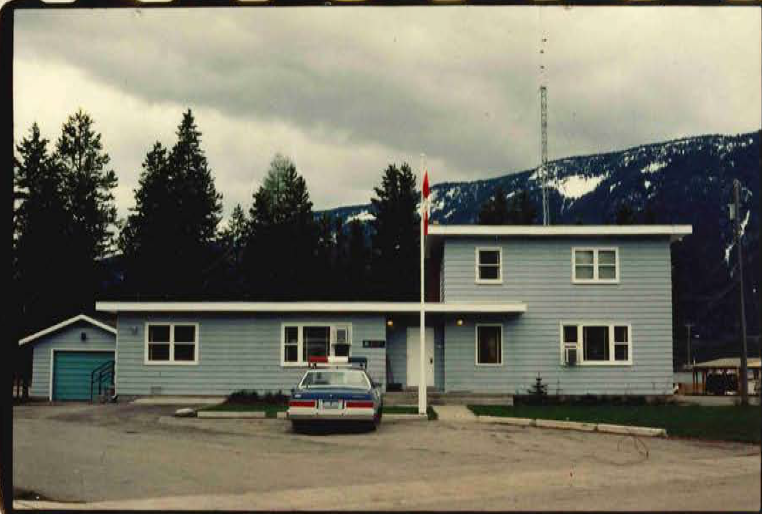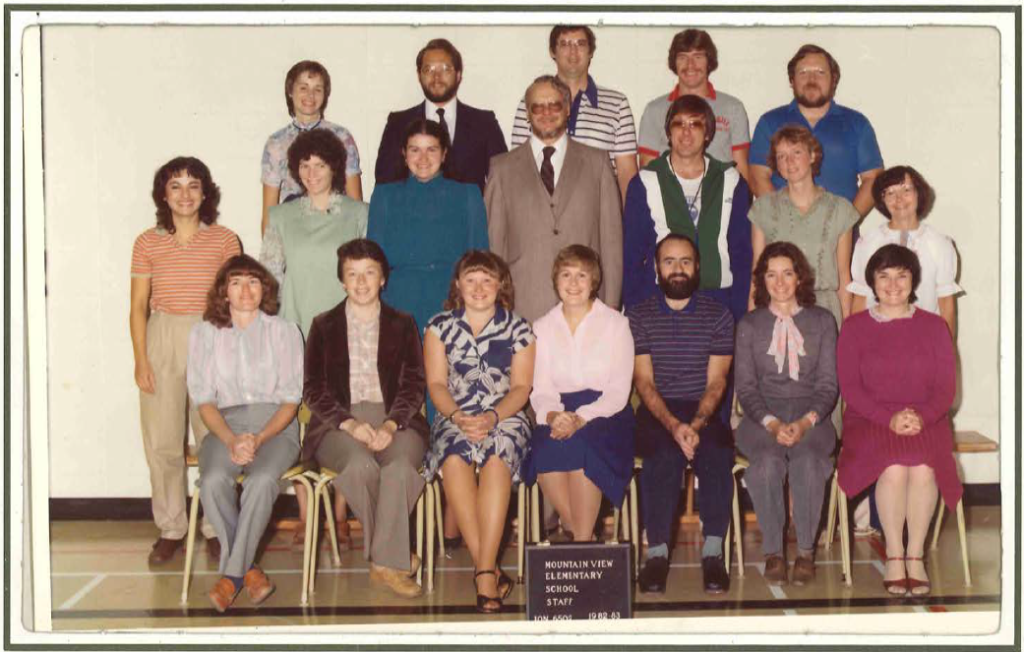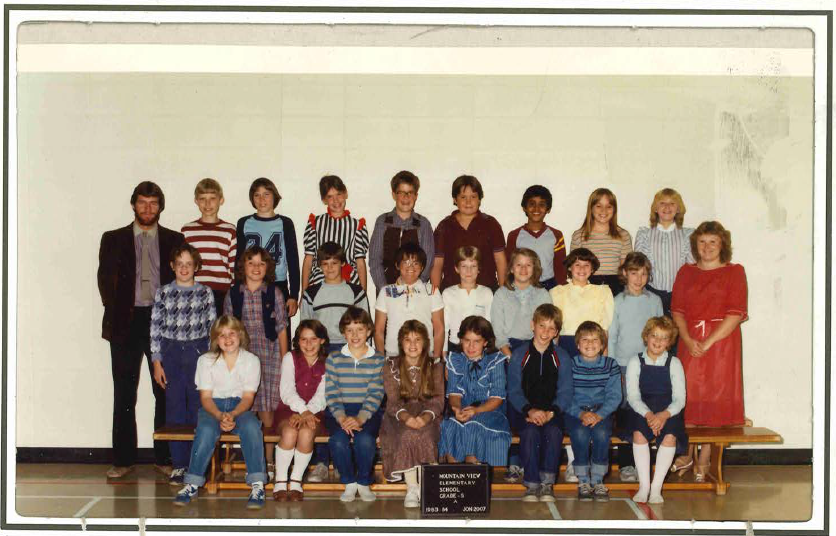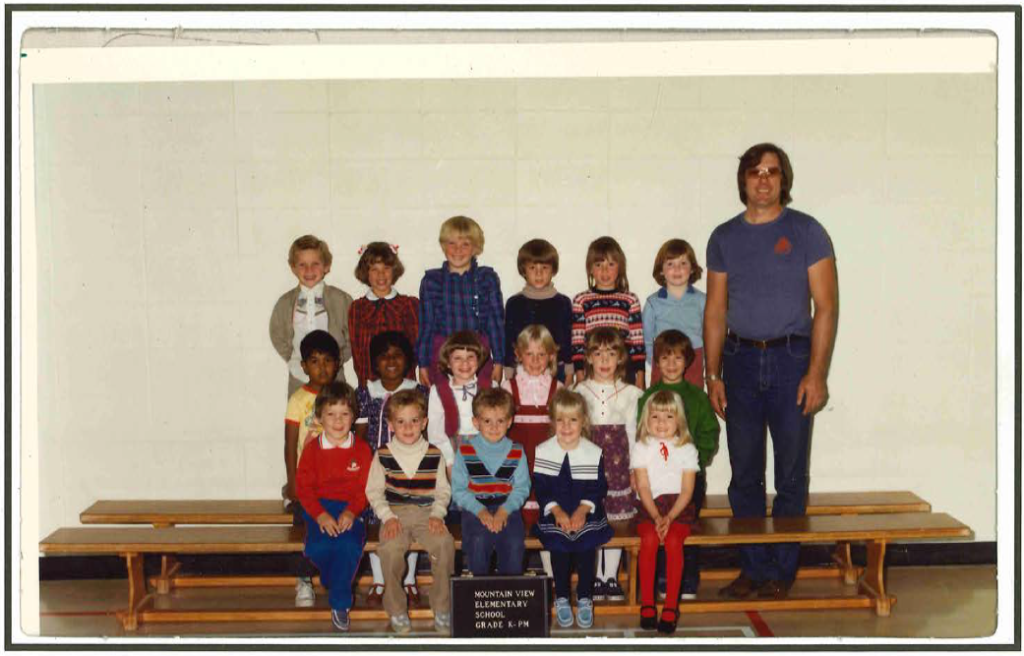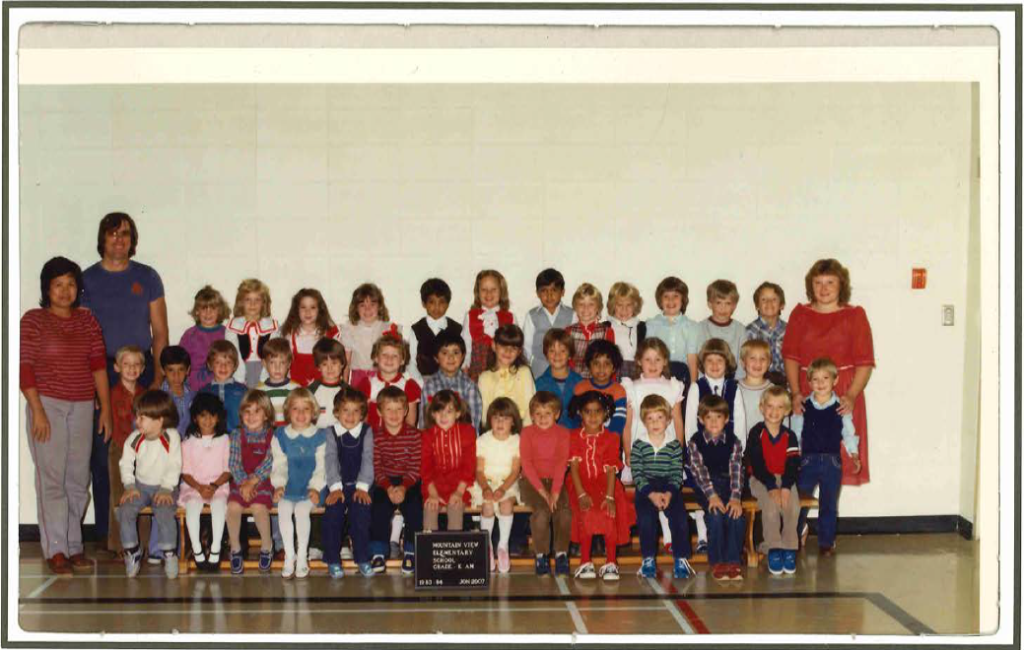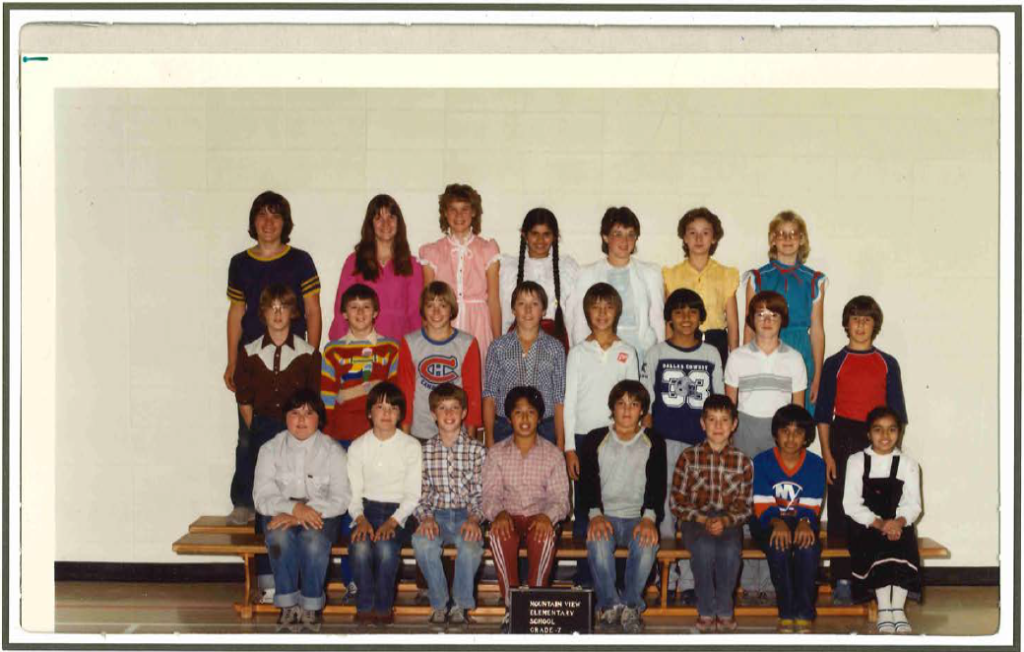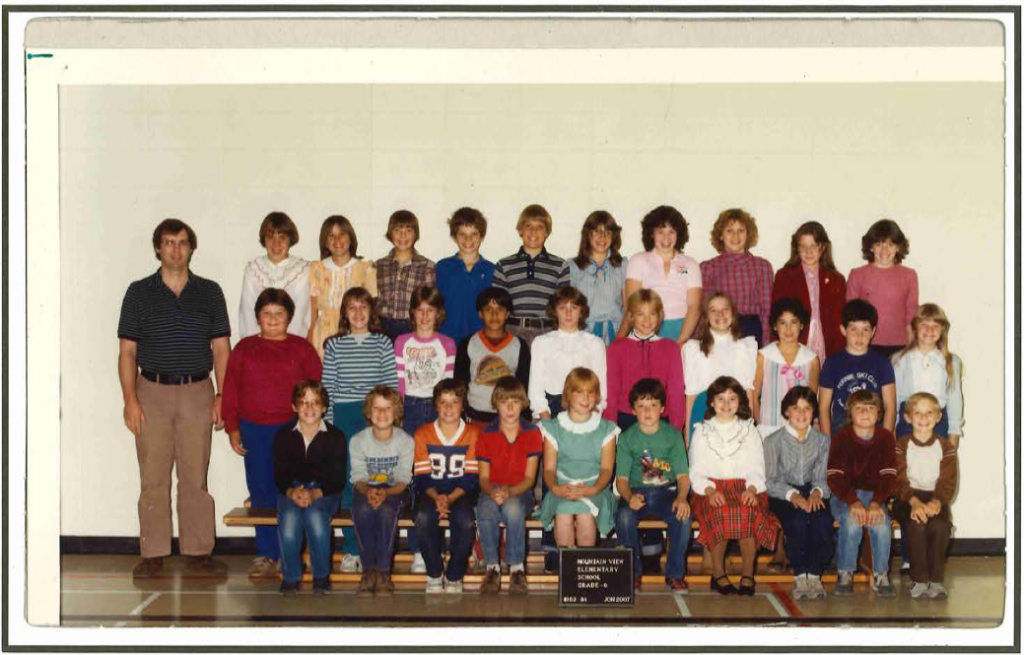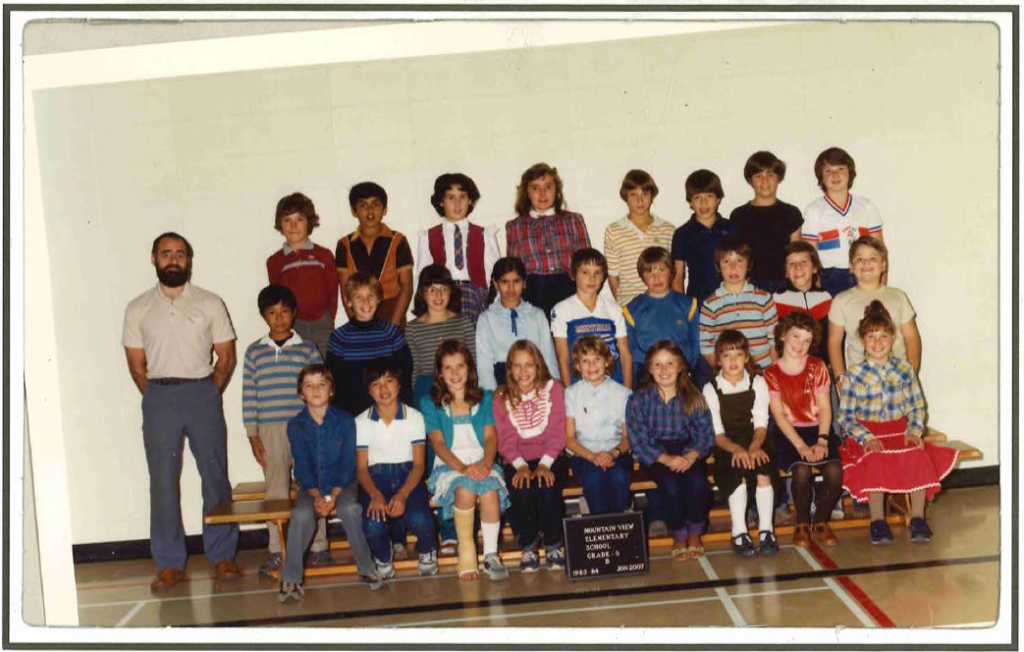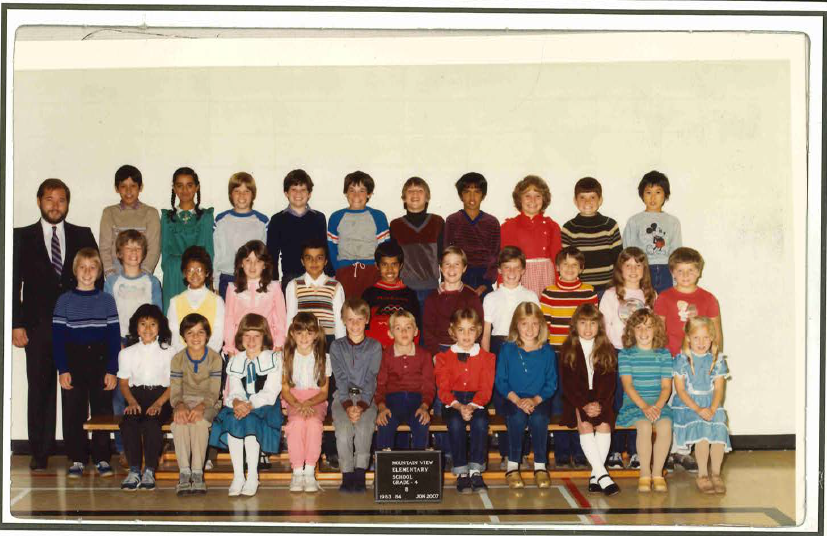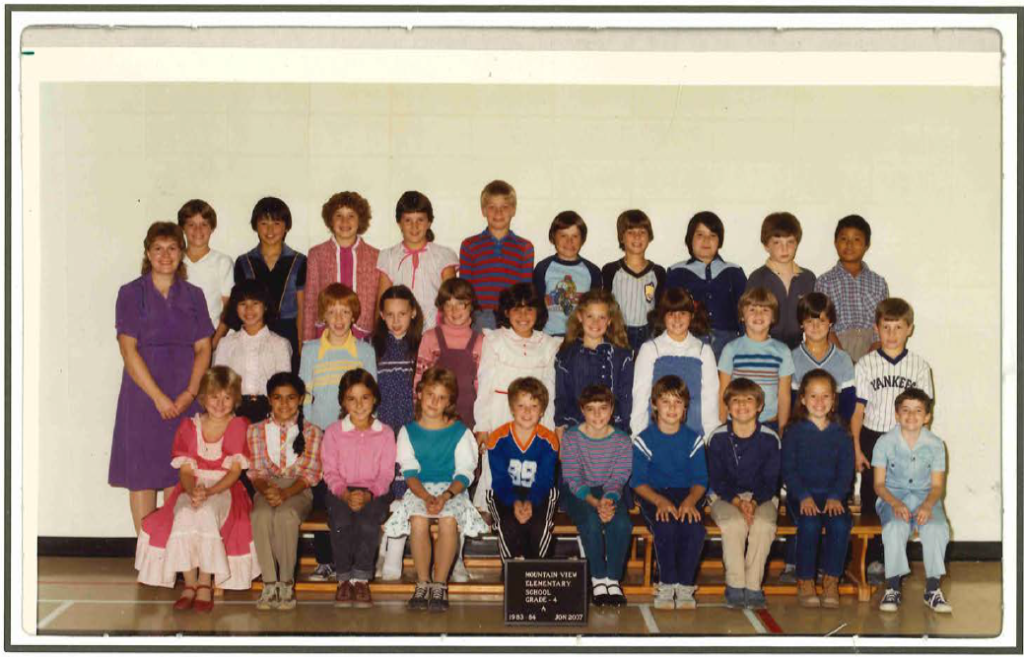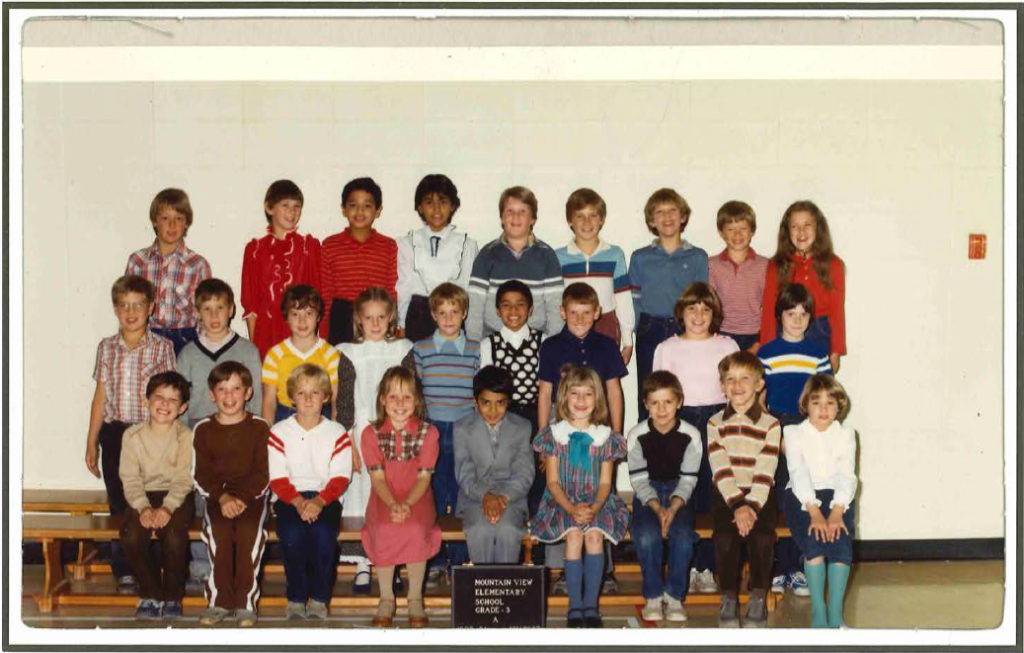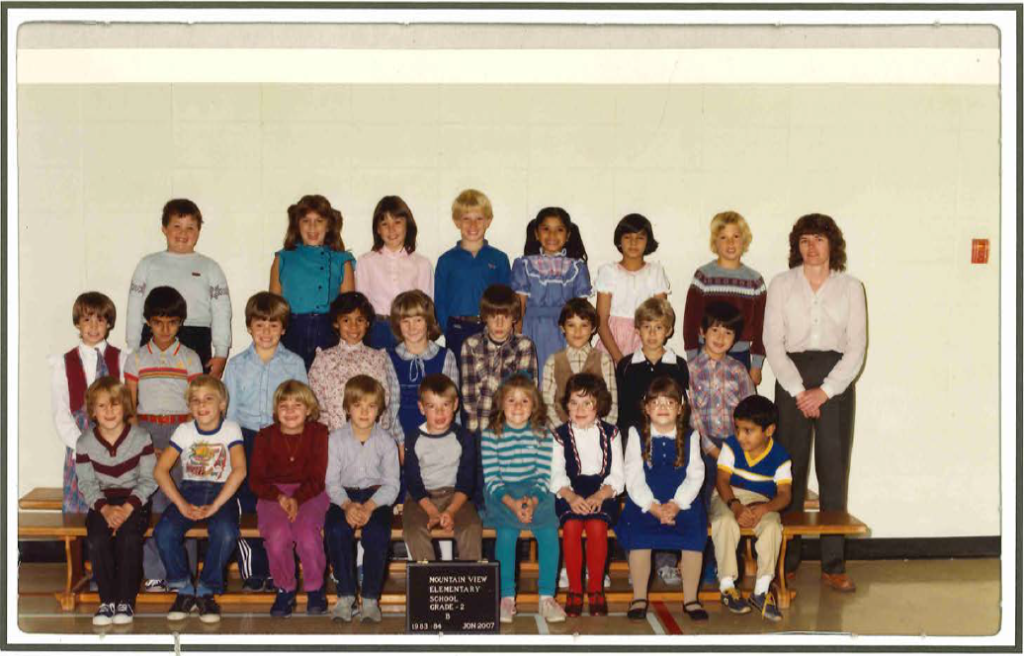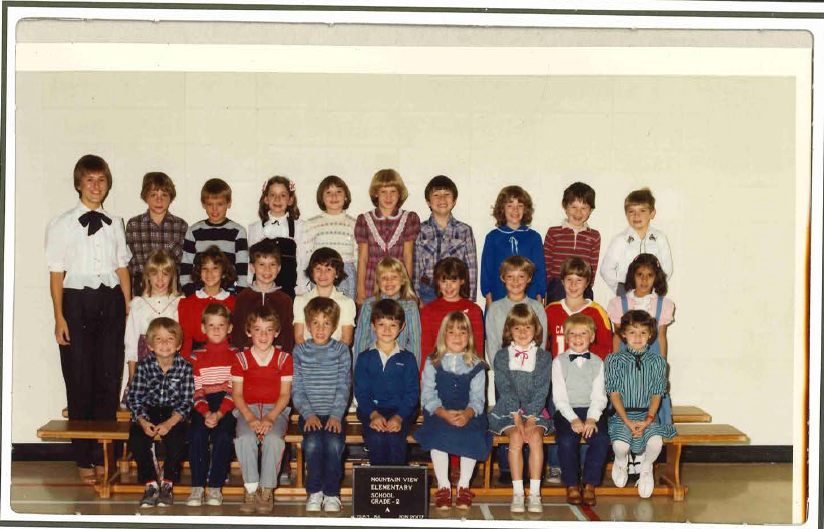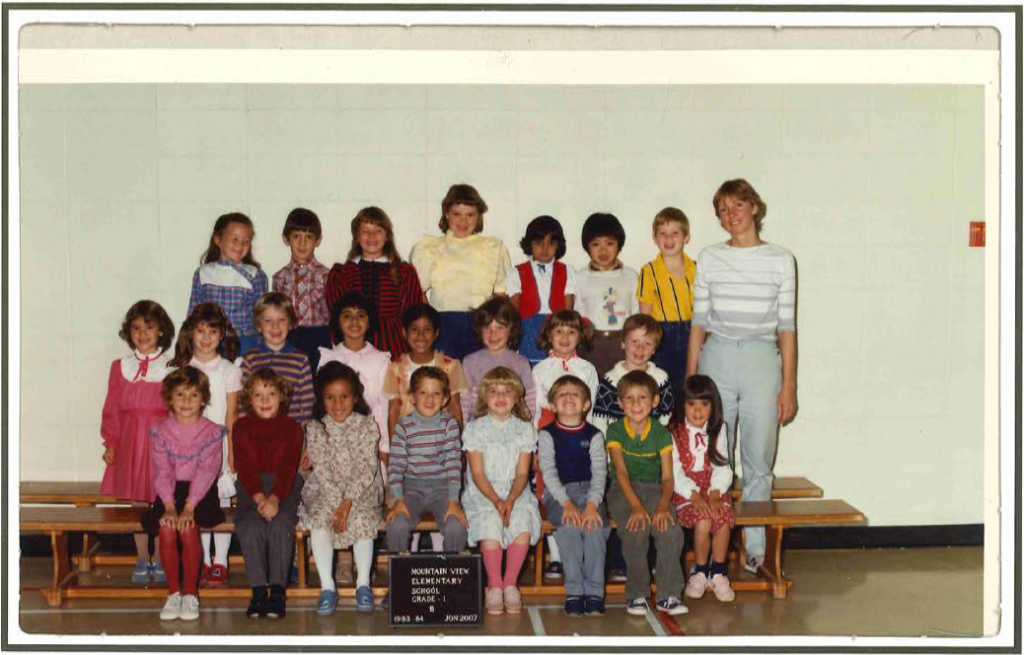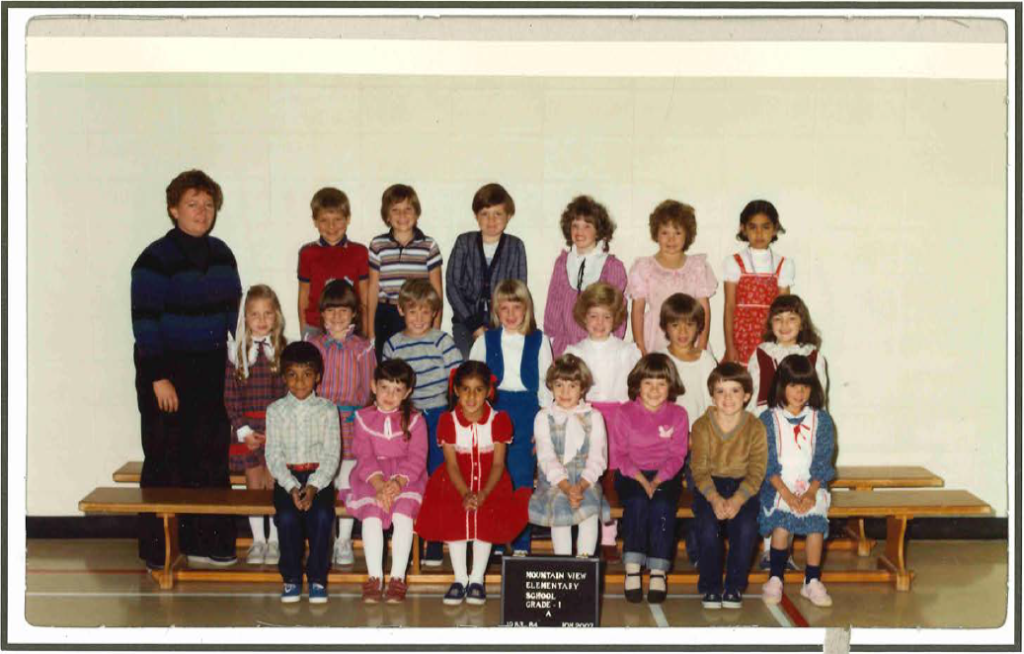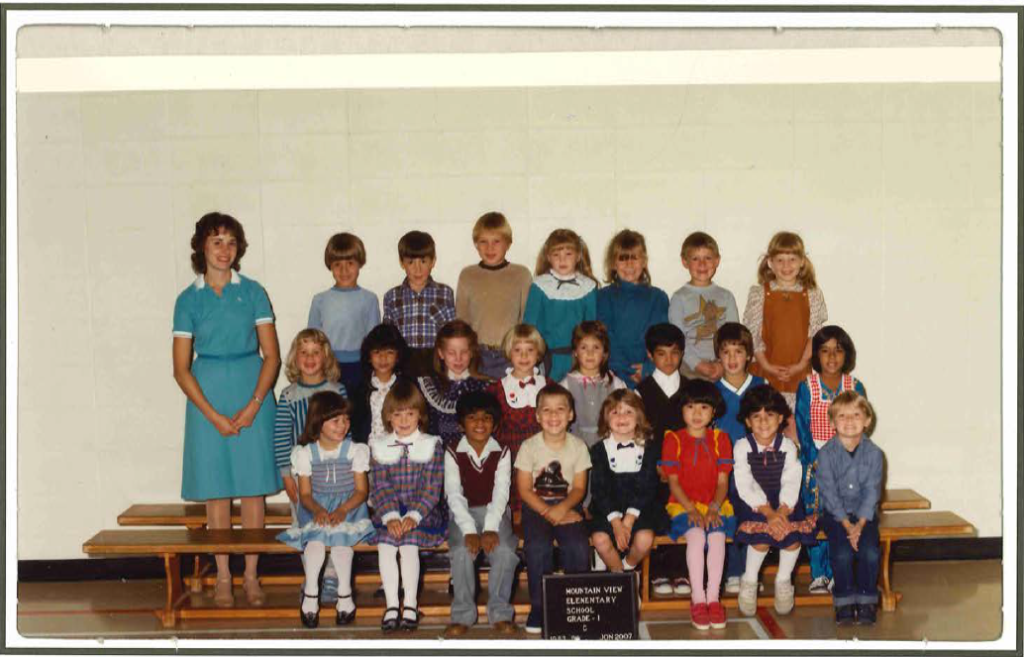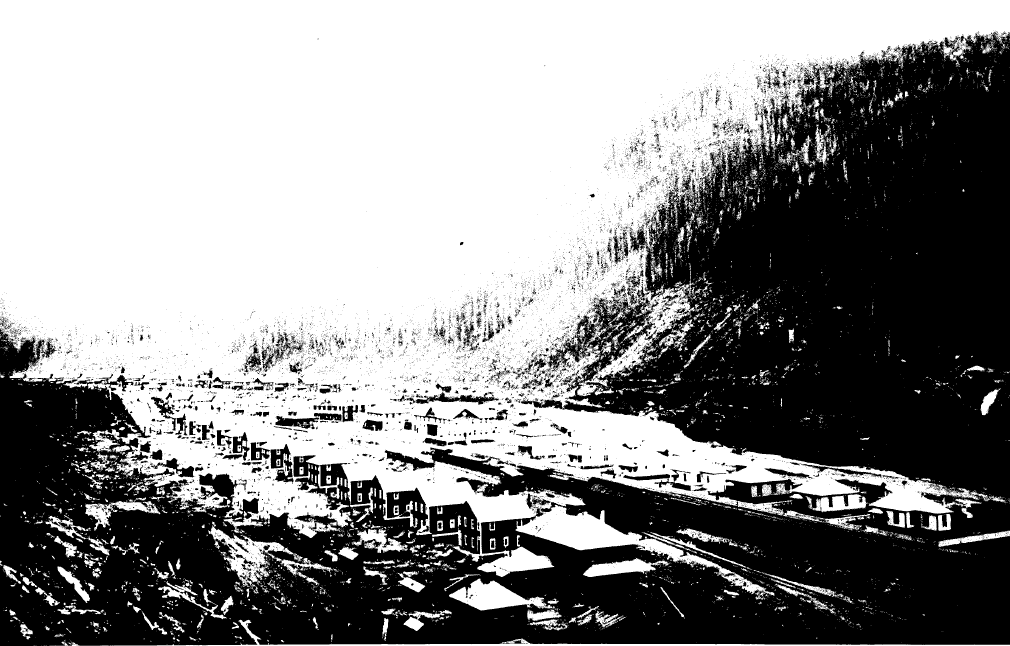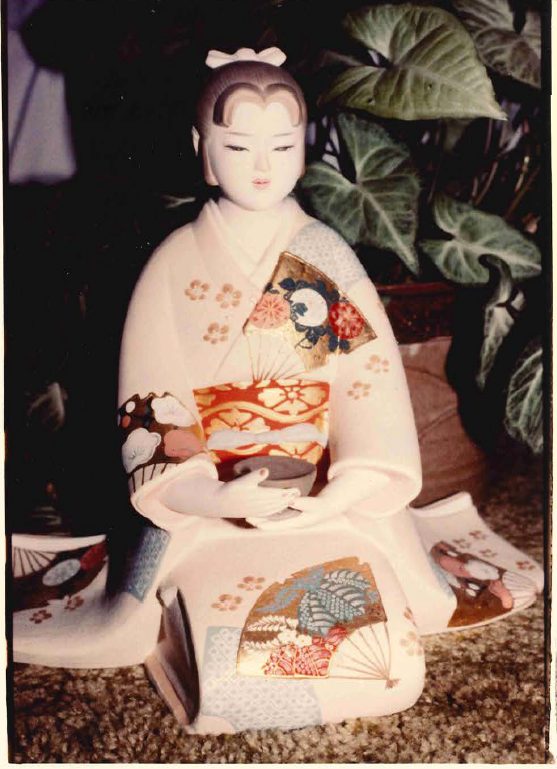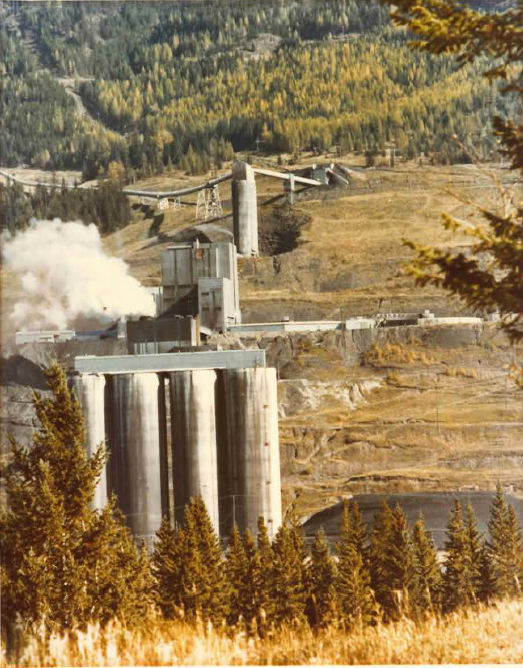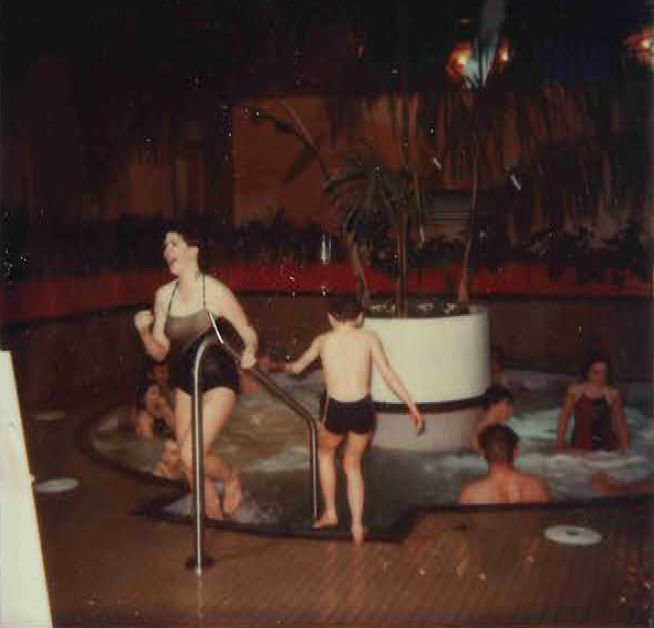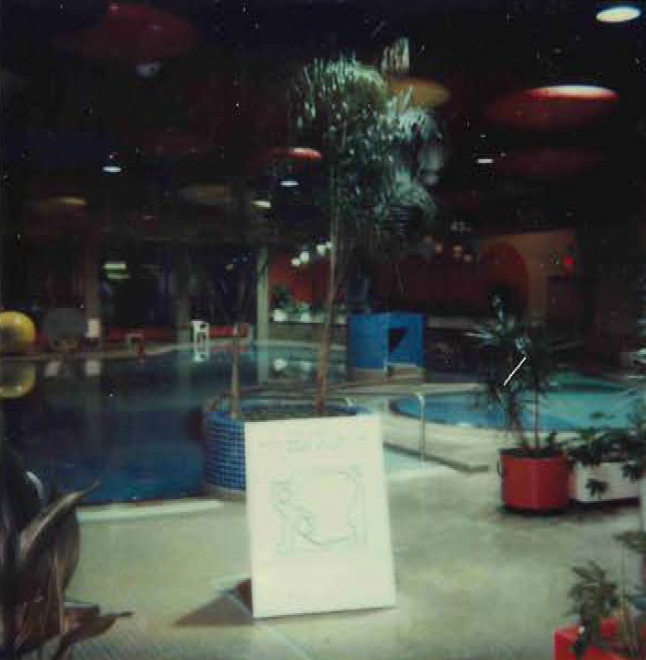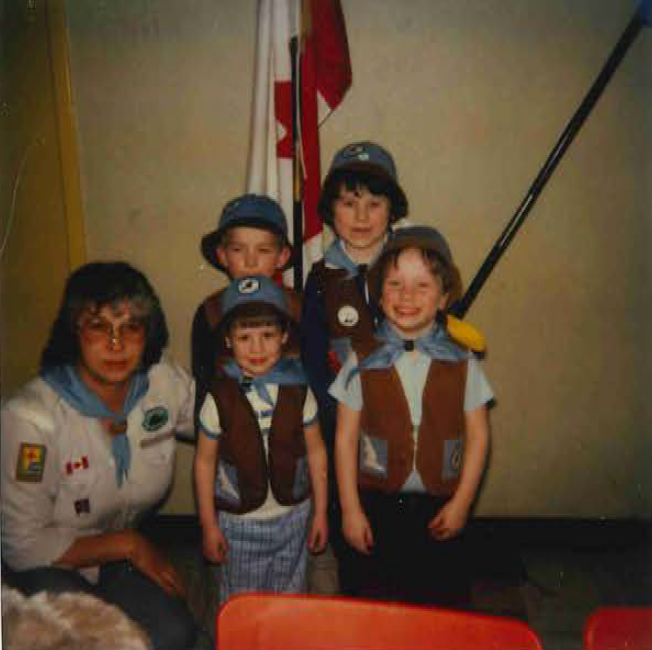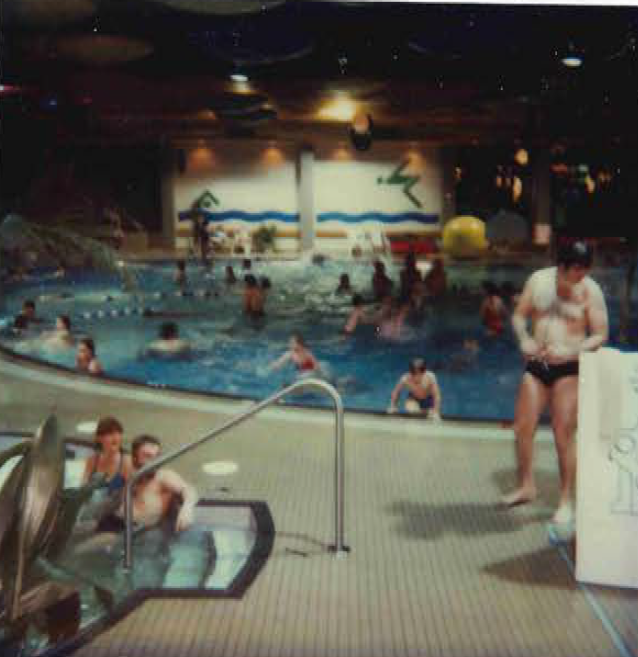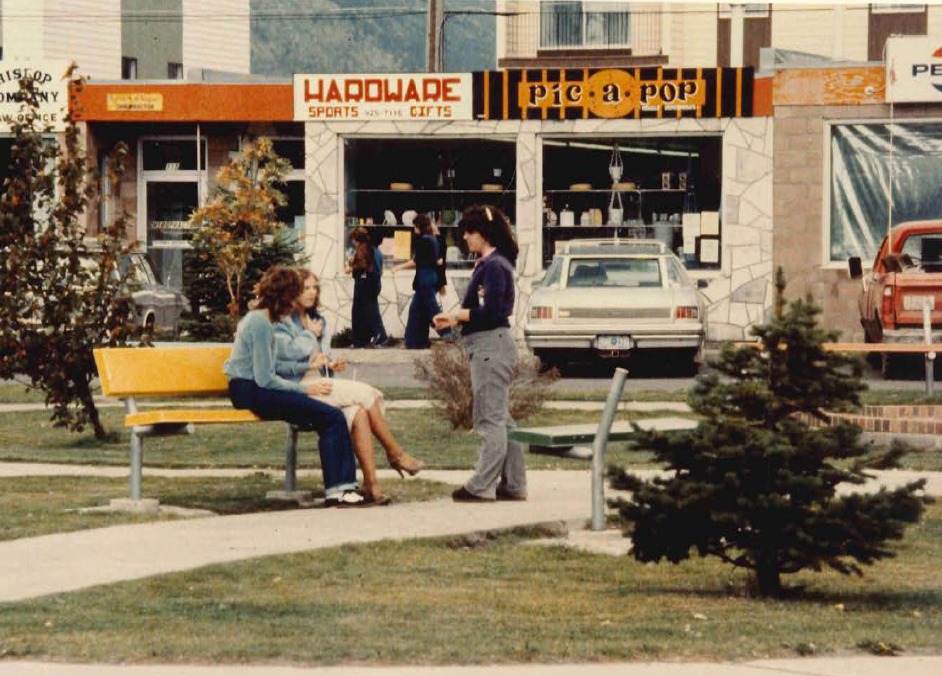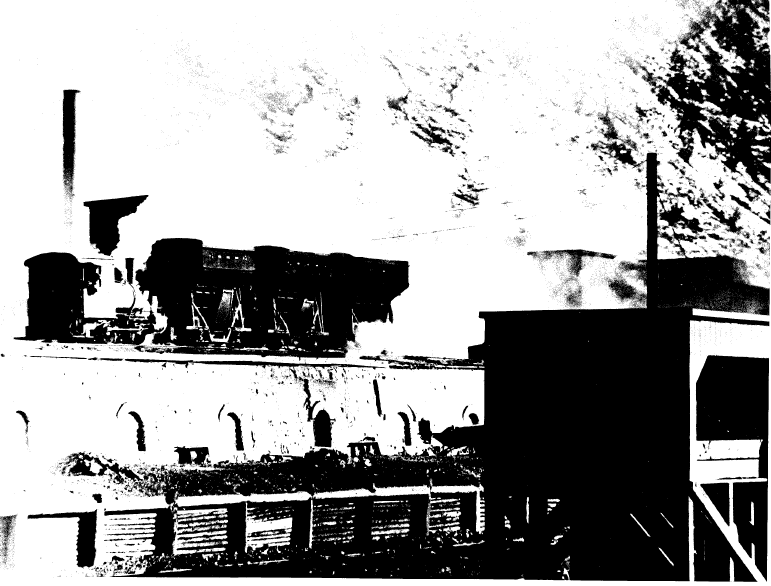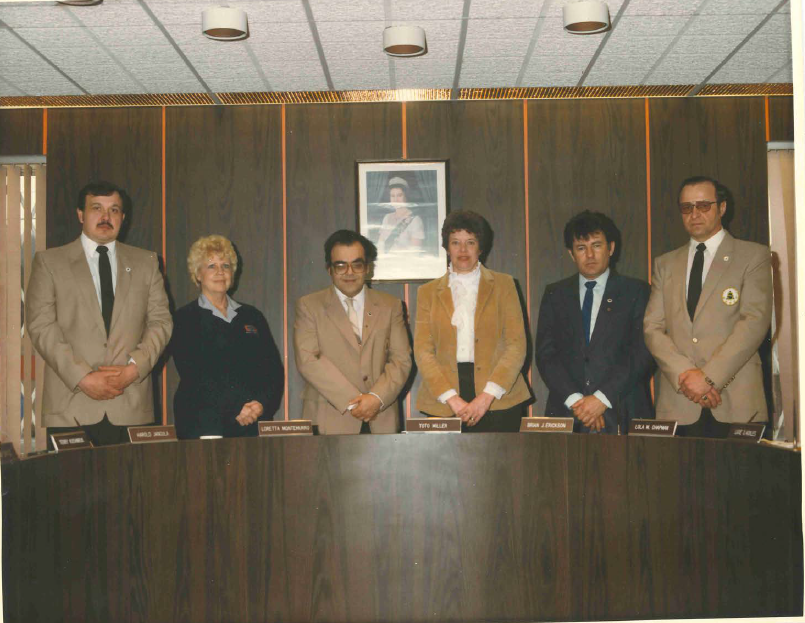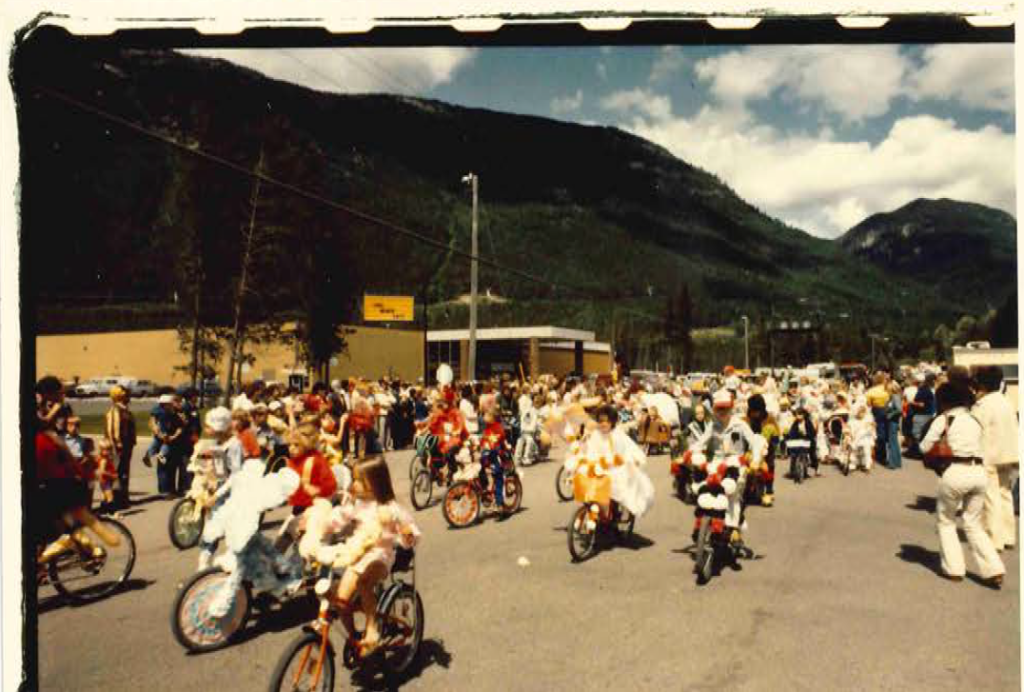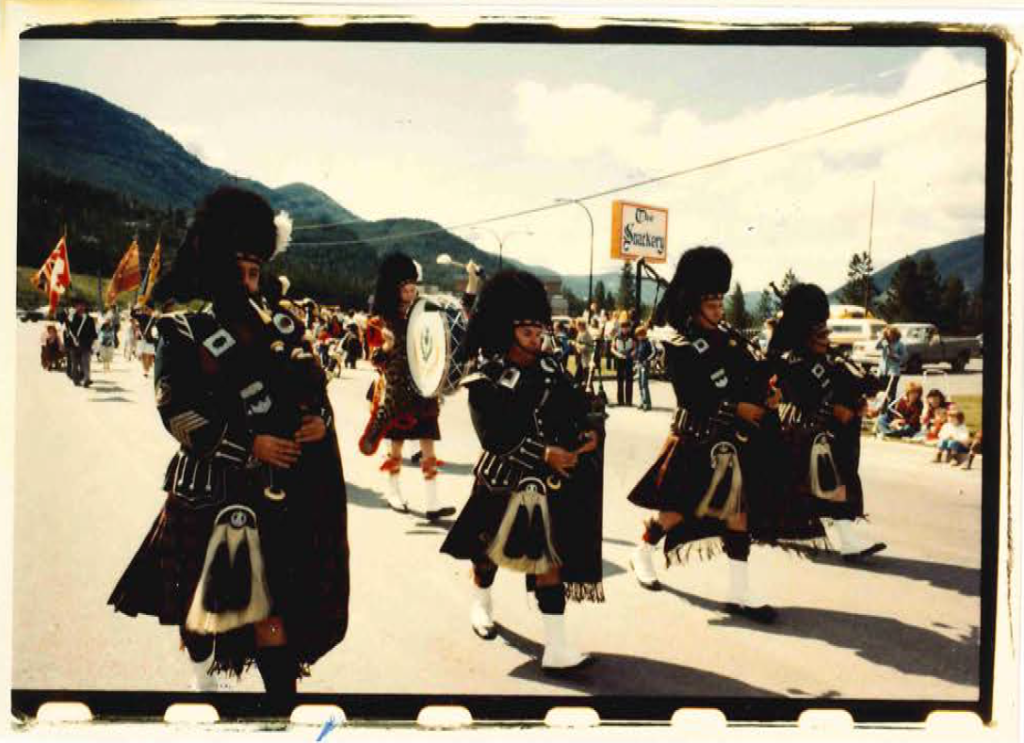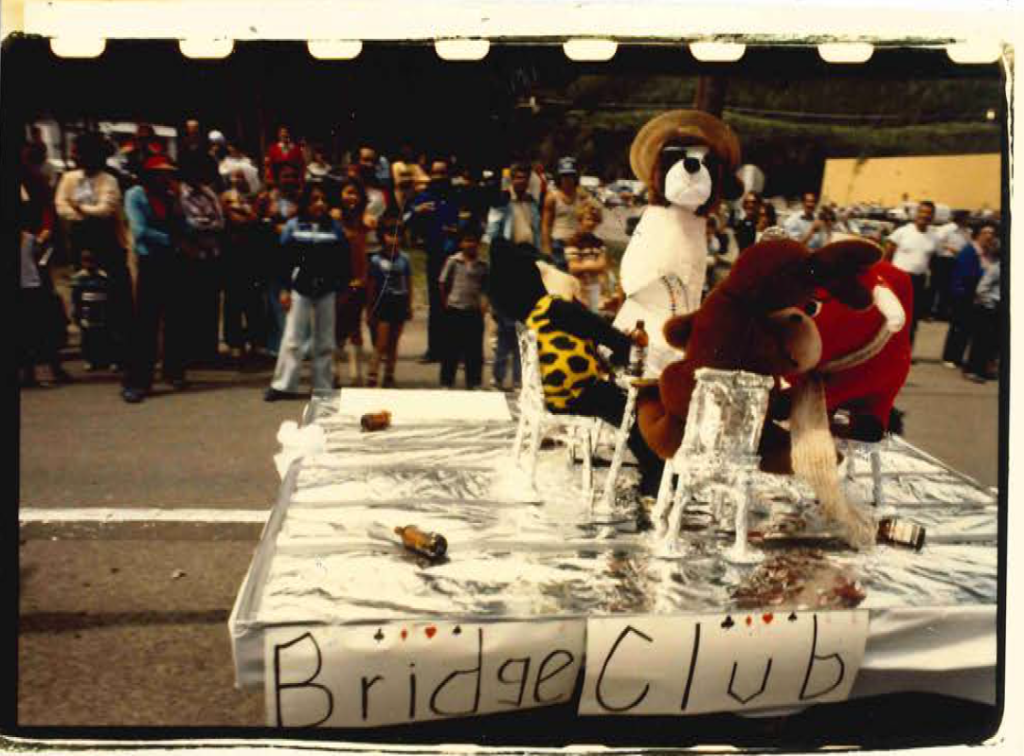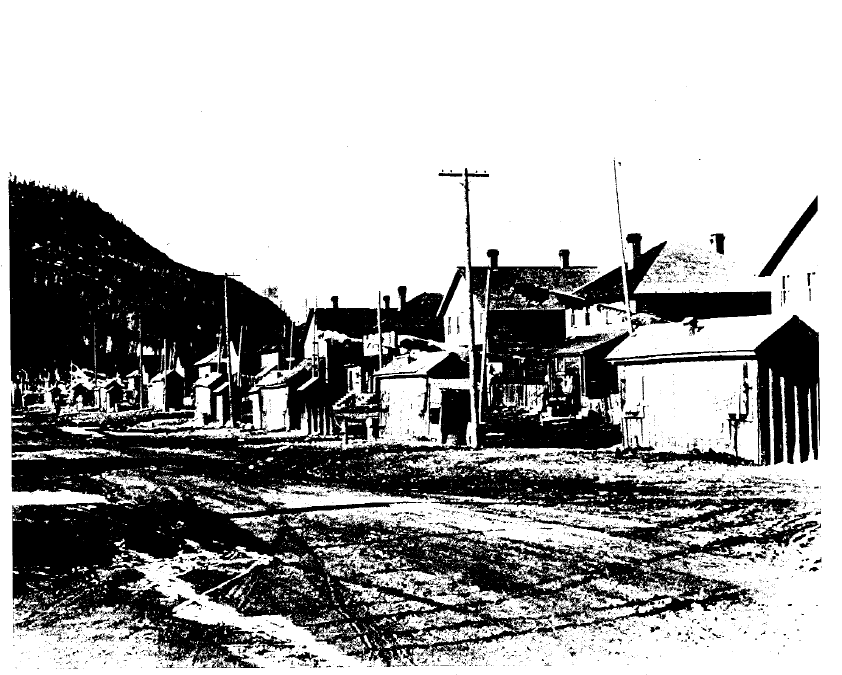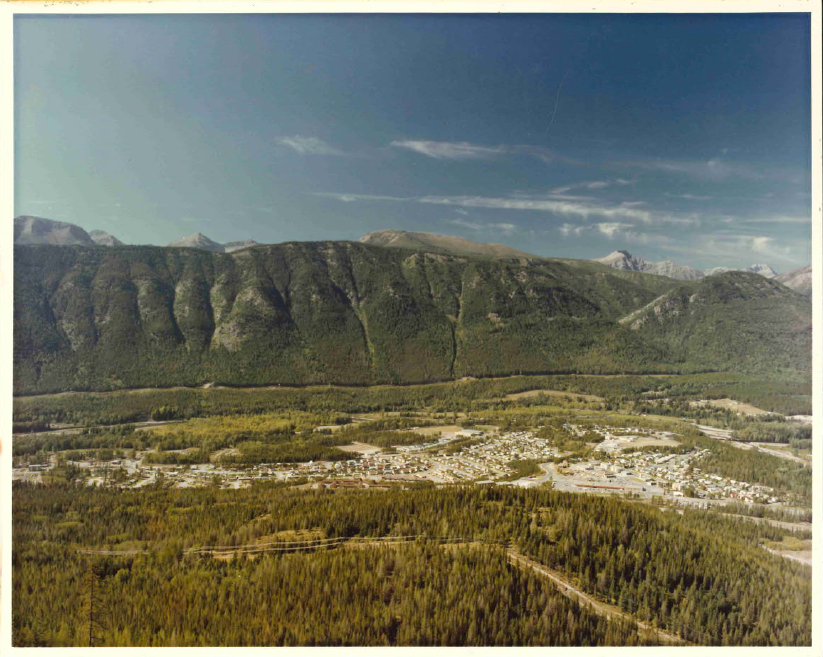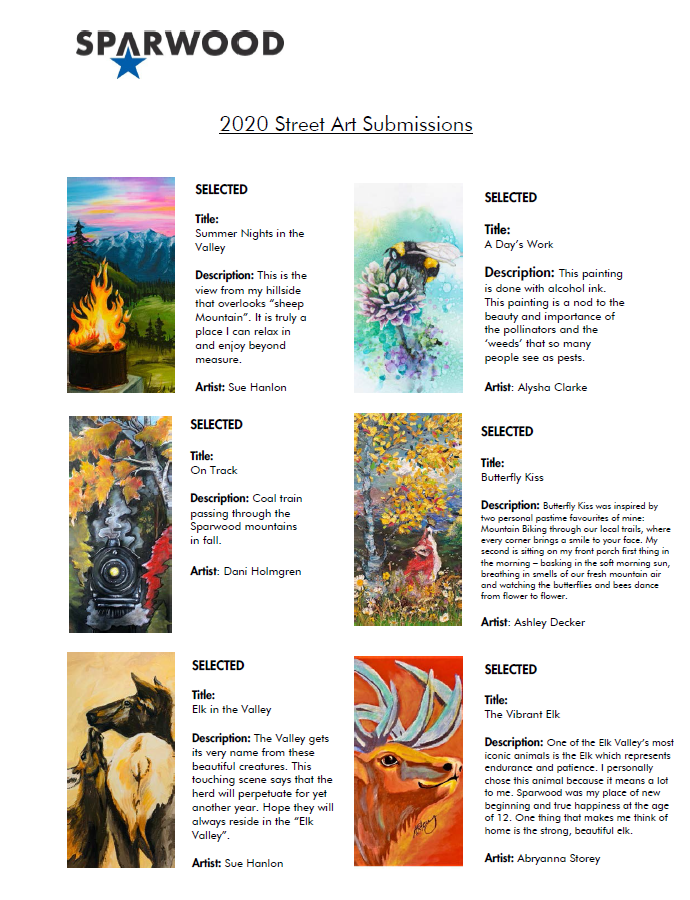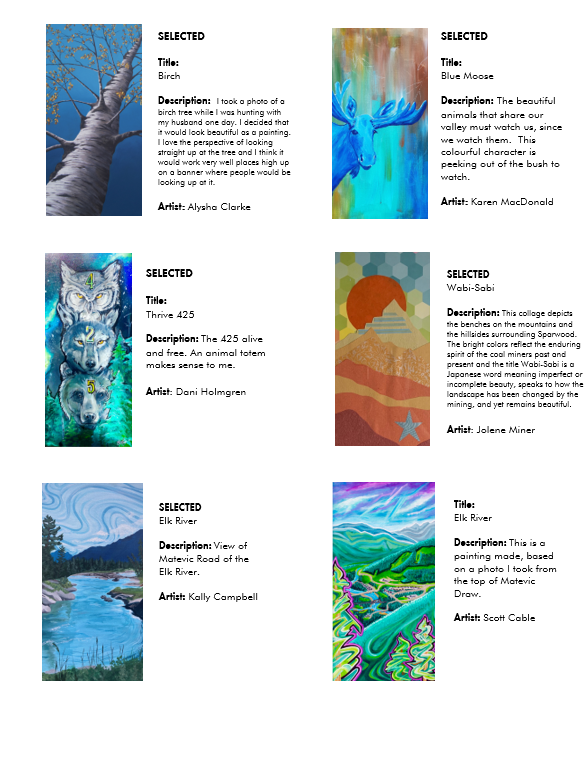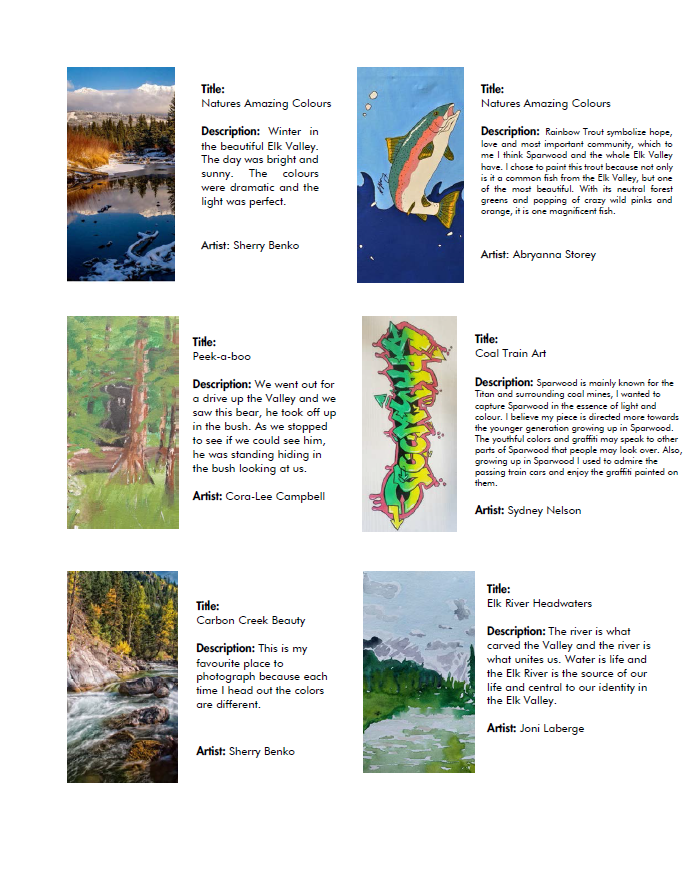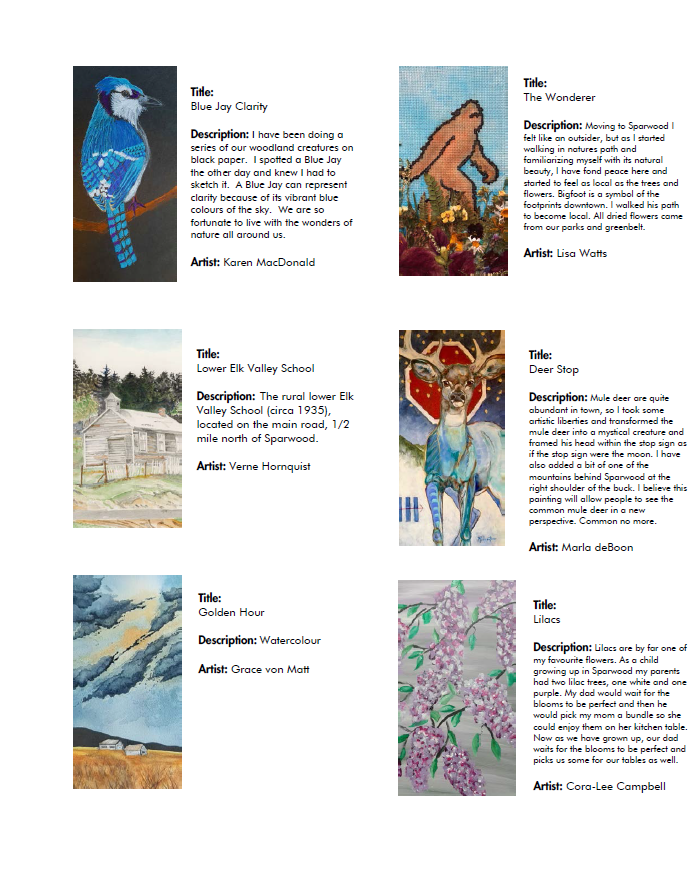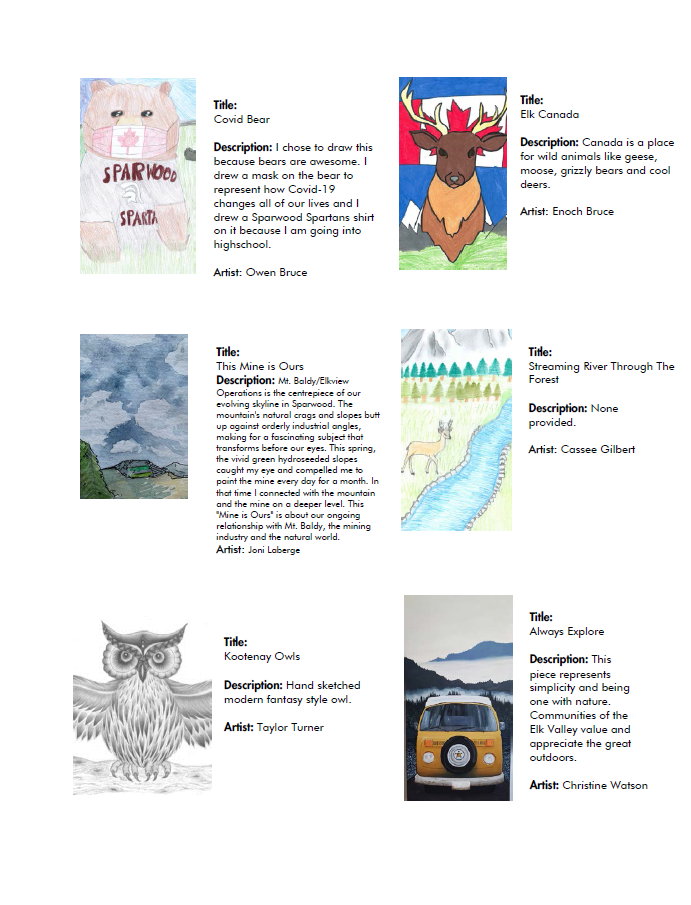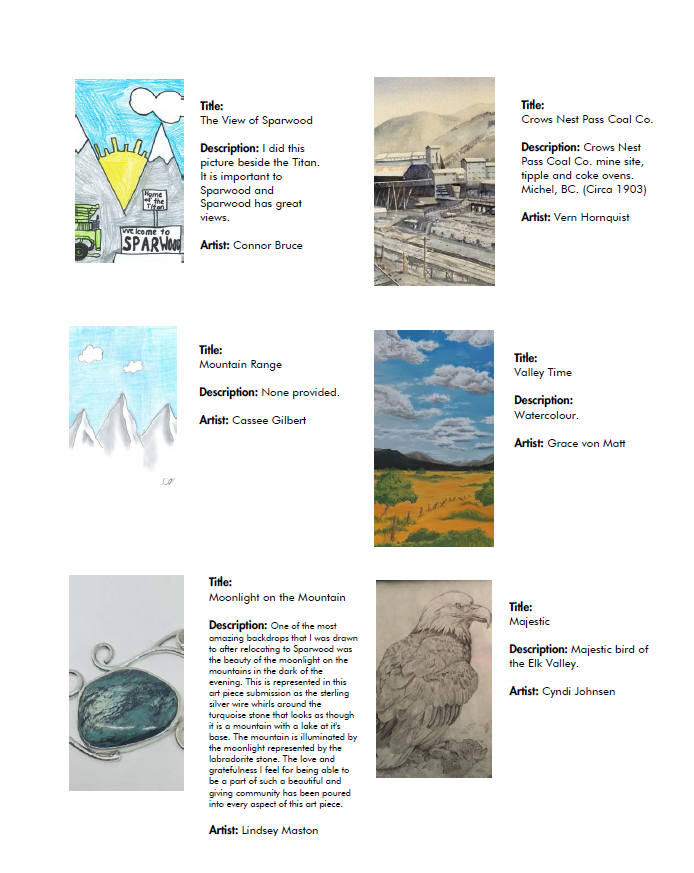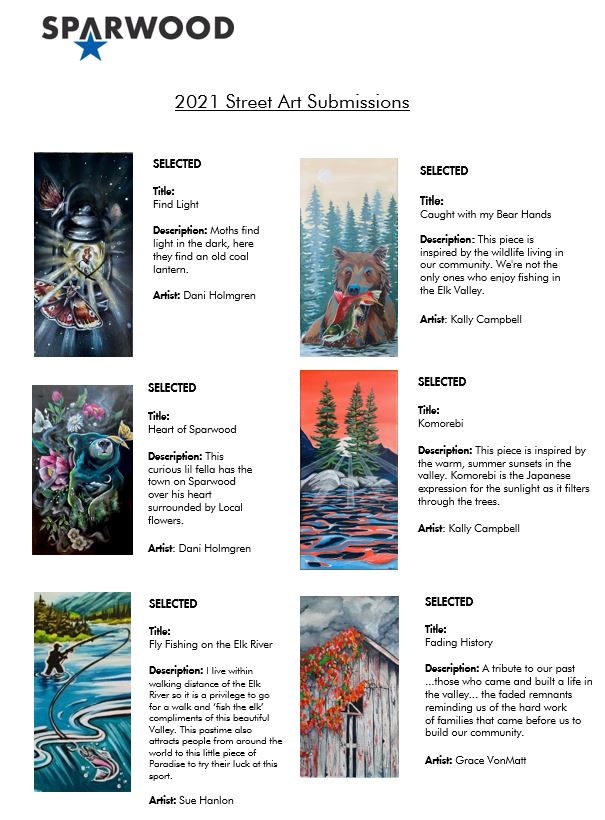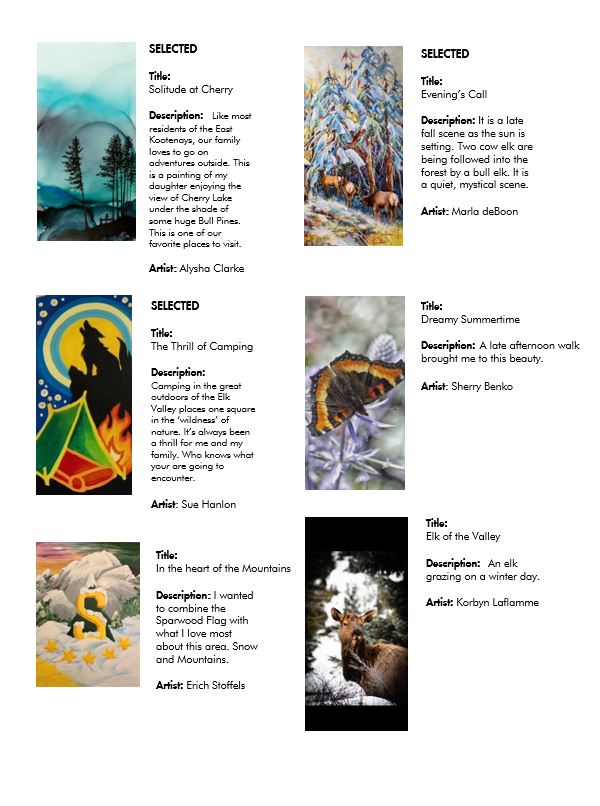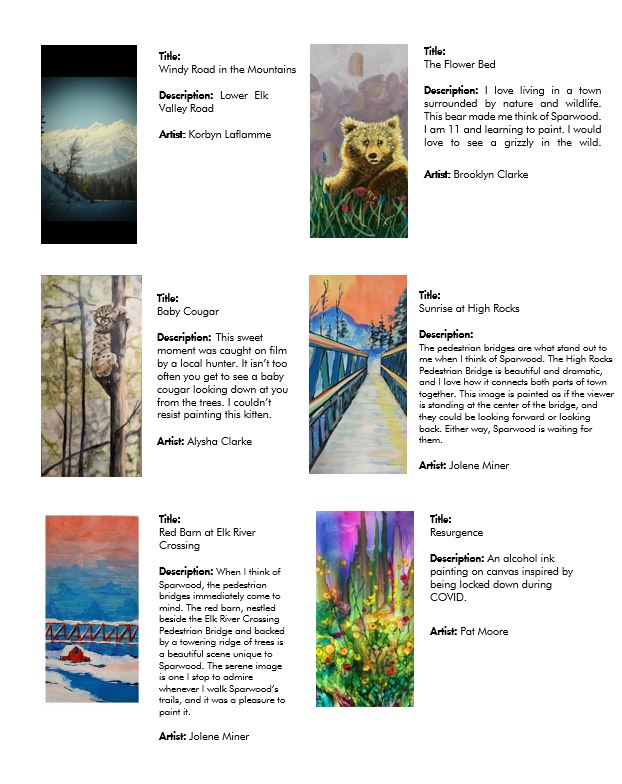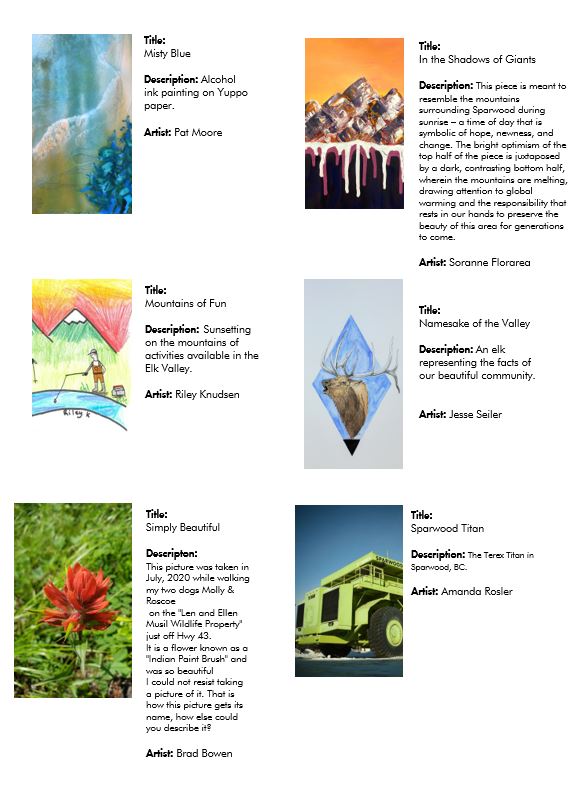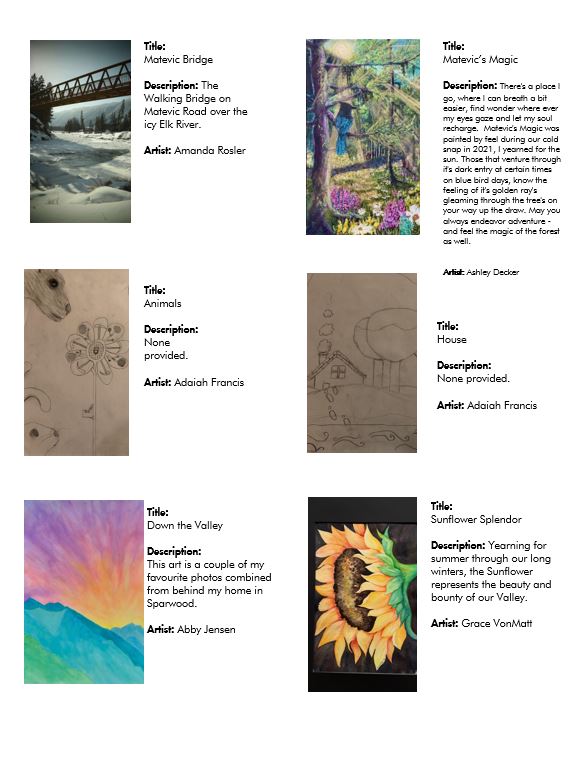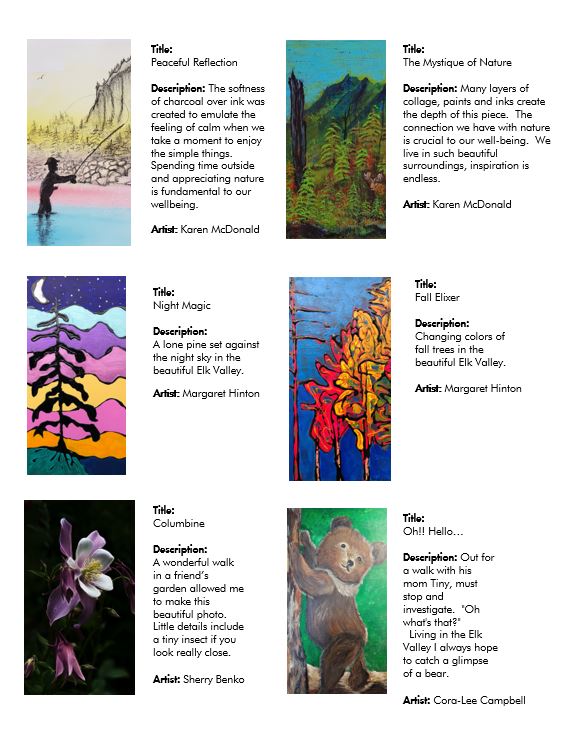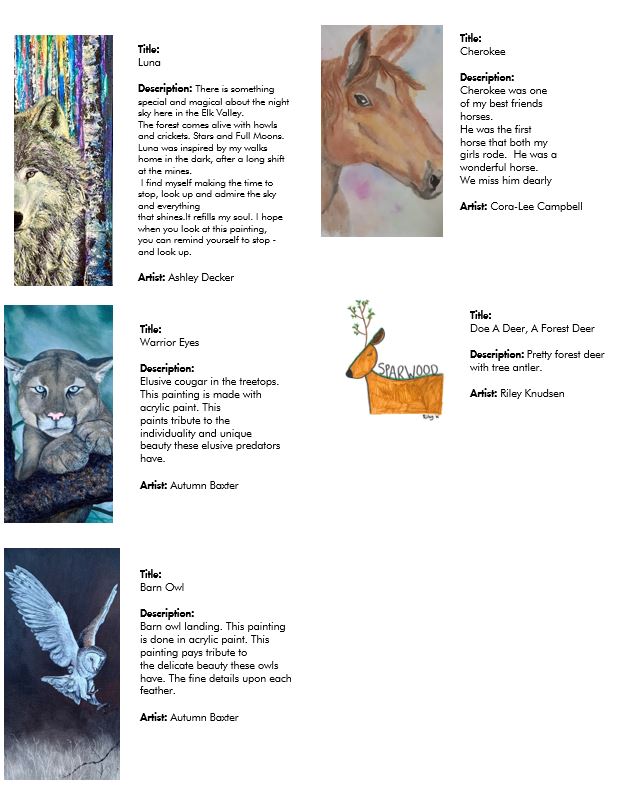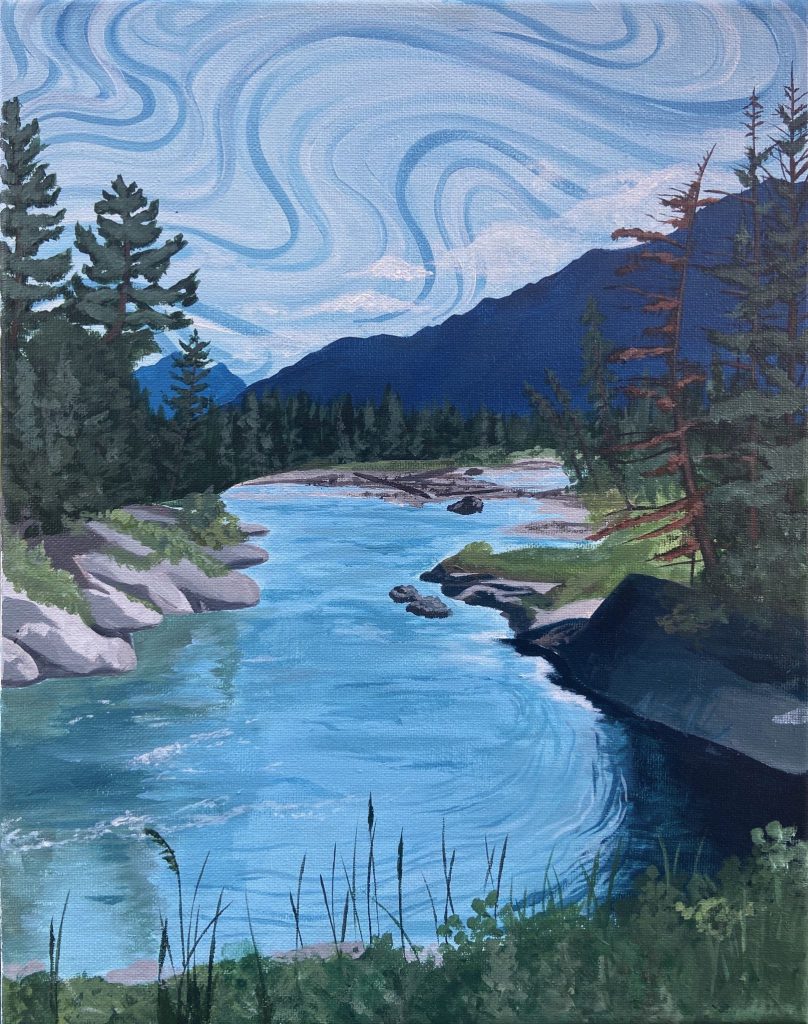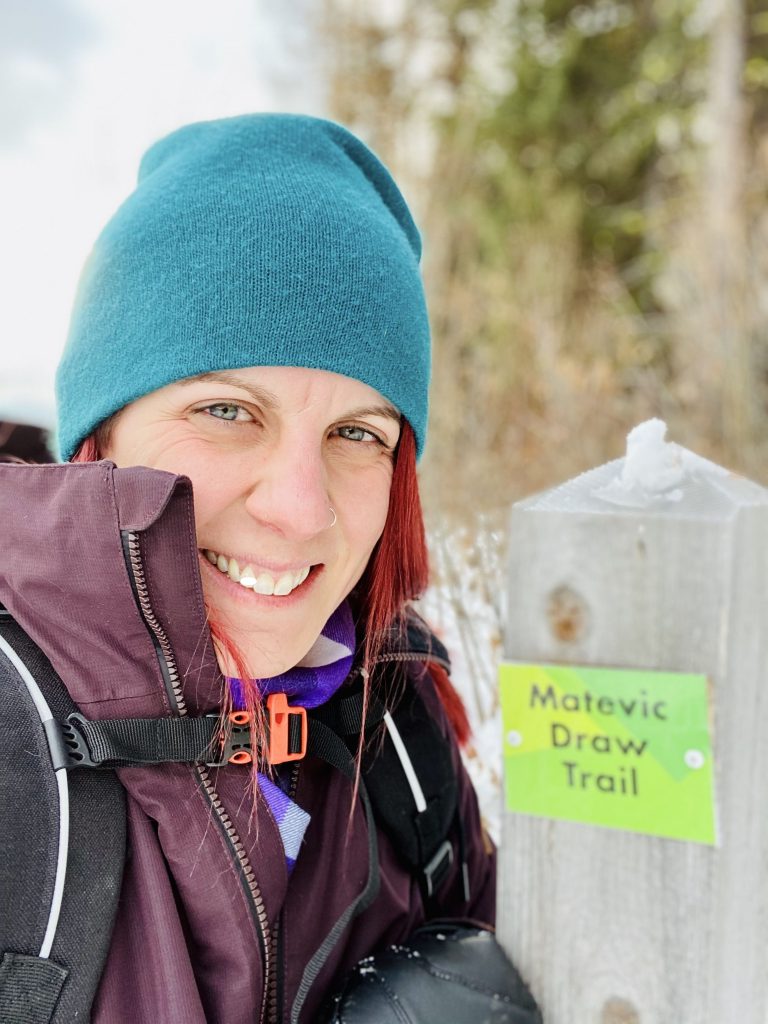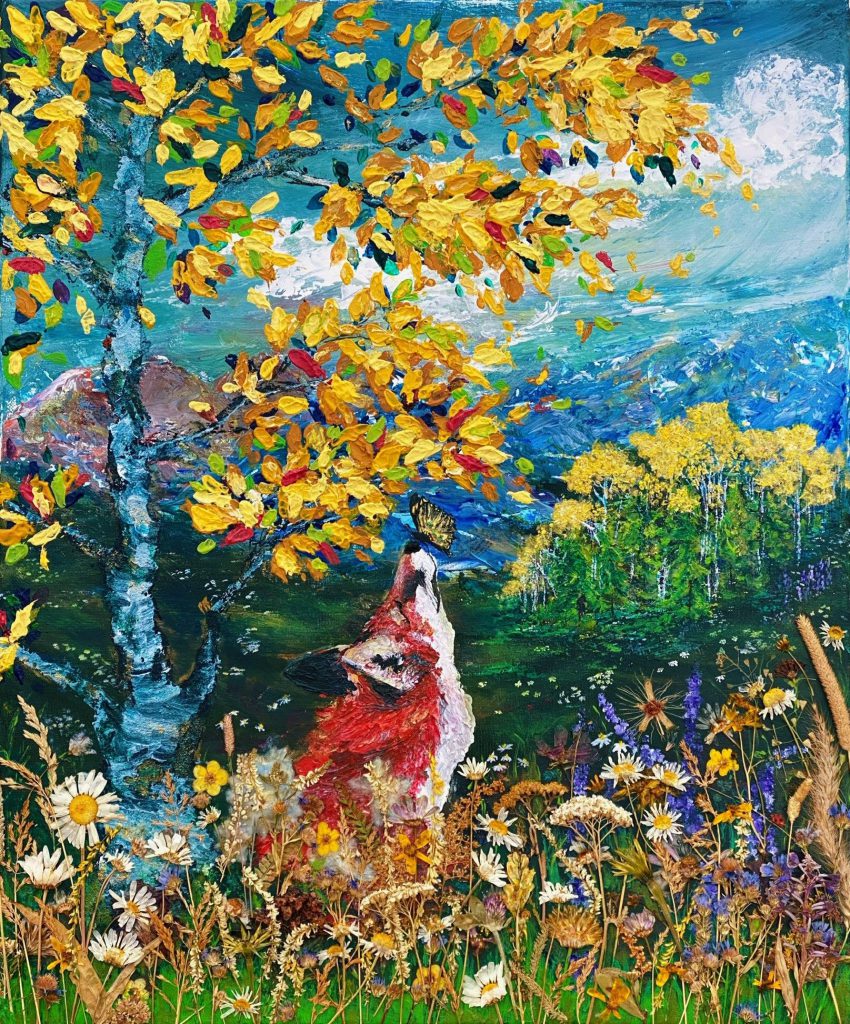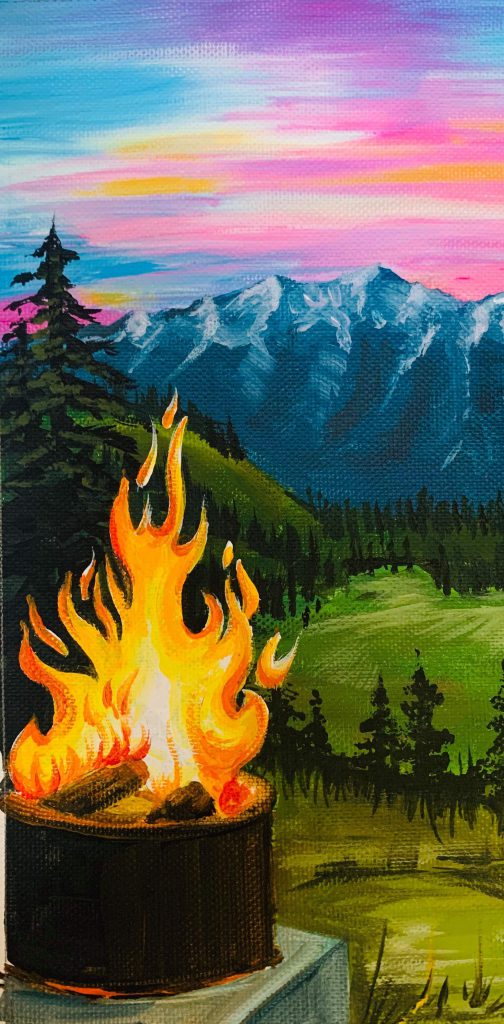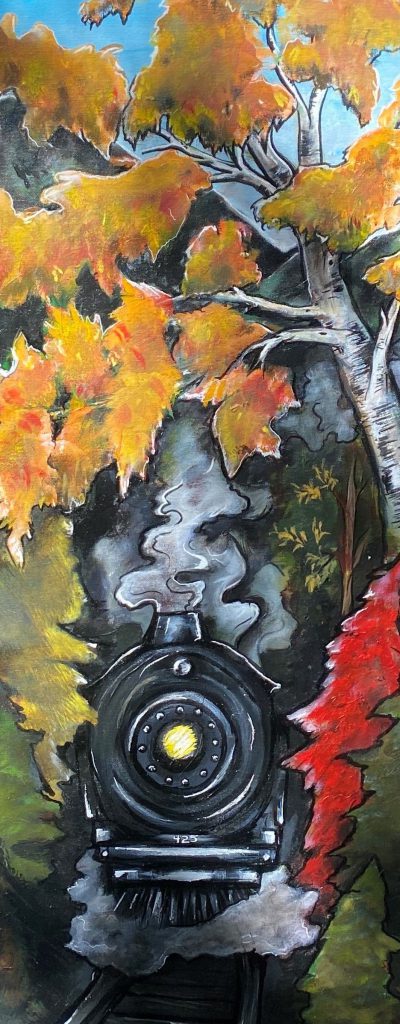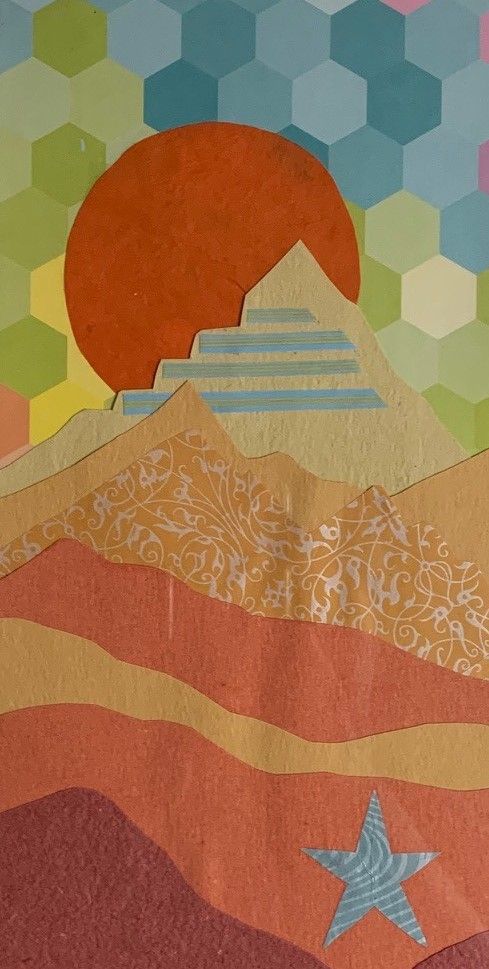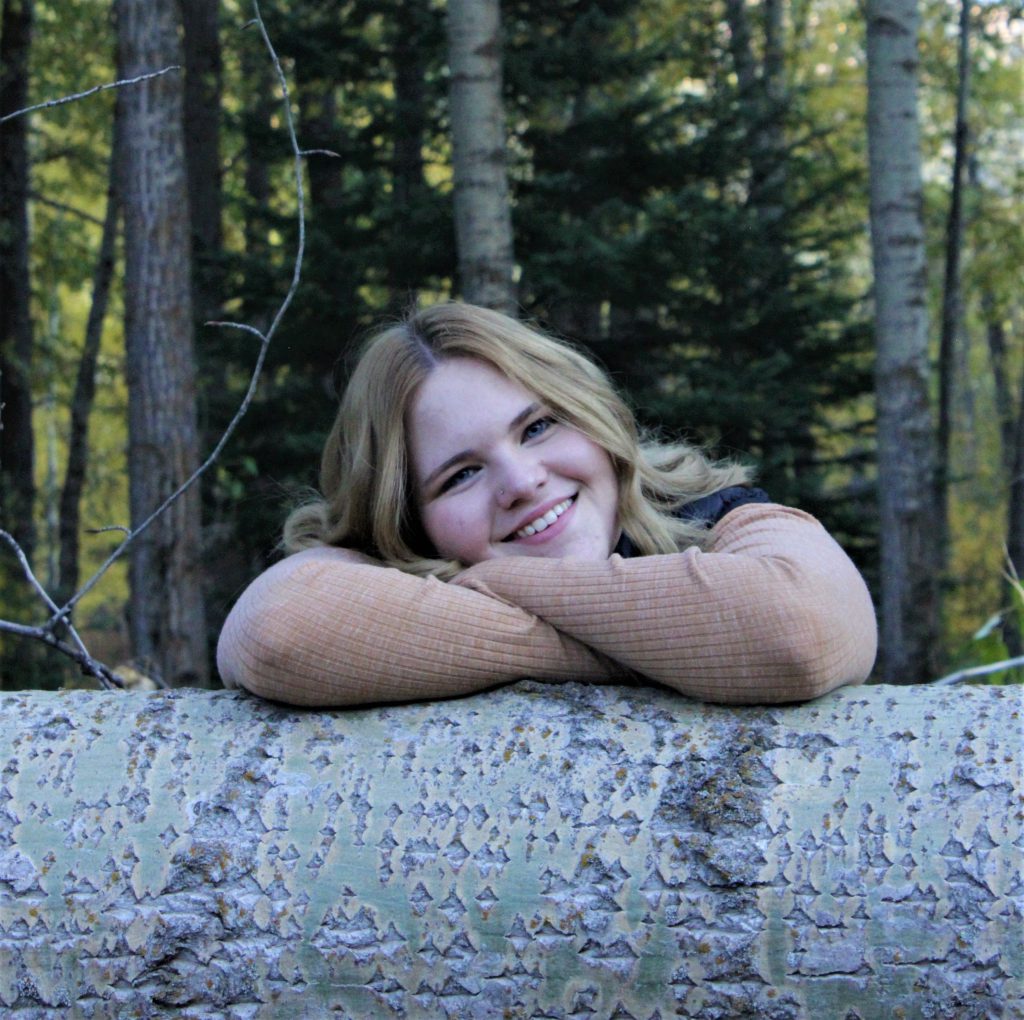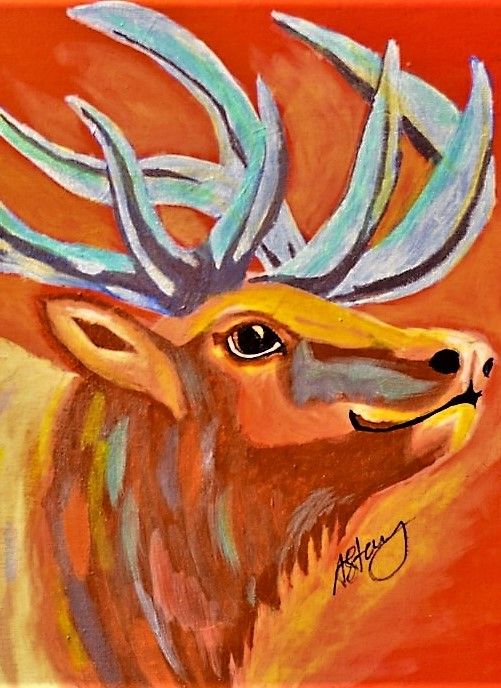Arts, culture and heritage activities in Sparwood make a difference in the lives of residents. The Community Services department develops vibrant and dynamic cultural programs as well as supports cultural organizations. With our partners, we aim to make Sparwood a creative community and a vibrant place of discovery, learning and exploration for all residents and visitors.
Come see what’s happening around town!
Art Programs
See It! Learn It! Do It!
The Sparwood Leisure Centre hosts various arts programs for all ages throughout the year at the Leisure Centre, including dance, guitar, piano, voice, photography and cooking lessons. Also visit the Sparwood & District Arts and heritage Council Facebook page for updates on local events and activities.
Visit sparwood.recdesk.ca for a full list of programs and sign up for a class today. It’s a great opportunity to try something new!
For more information, contact Leisure Centre staff at 250.425.0552 or recoffice@sparwood.ca.
Farmers Market
Looking to buy local and support the community?
Well you are in the right place! The Sparwood Market is an ideal way to purchase local, fresh, and in-season produce and products to support our community. The Sparwood Market is a non-profit organization and a proud member of the BC Association of Farmers’ Markets.
The market is located in Titan Park and is open every Friday afternoon during the summer months (July to mid September) from 4:00 pm – 7:00 pm. There is ample parking available across the street at the Greenwood Mall.
There’s something for everyone at the Sparwood Market!
Come out and enjoy the live music, yummy baked goods and fare from the food trucks. You will also find beautiful homemade goodies, art, jewellery and so much more.
Visit the Sparwood Market’s website at www.sparwoodmarket.com or email them at contact@sparwoodmarket.com to find out about upcoming events, music or becoming a vendor.
History
It began with a whistle stop
Prior to 1900, there was a railroad stop in the region known as Sparwood, which was so named because of the trees from this area being shipped to the Coast for manufacturing spars for ocean vessels.
In the late 1800s and early 1900s, coal development in our region resulted in the creation of three small communities known as Michel, Natal and Sparwood, respectively. The former two communities were in the immediate area of the coal mines and the latter, Sparwood, was a few miles removed.
By 1966, the Village of Natal and the settlement of Michel had become adversely affected by coal dust. The Village of Natal, in cooperation with the Provincial and Federal Governments, entered into an Urban Renewal and Land Assembly program, which eventually resulted in the townspeople of Natal and Michel moving to Sparwood. Sparwood has a storied collection of tales and events all shaped by the coal industry, and the strength of the community is still proudly founded on the coal for which it all began.
Learn more about our local history and the communities that came together to form Sparwood at the Sparwood Museum or visit them online at https://sparwoodmuseum.ca/
Learn more about the history of Michel and Natal in That’s the Price, by Michael Scott.
Library
Libraries are an important resource within our community
The Sparwood Public Library offers a wide variety of online and print books, programs and activities. Library cards are free to anyone living in Sparwood which allows you to access the library’s physical and digital collections. The library also offers a number of programs for children, youth and adults. Non-residents can purchase a temporary card for $10.00 which is valid for 6 months or if you are a member of another BC Library, you may be eligible for a BC OneCard. For more information visit on program times and activities visit https://sparwood.bc.libraries.coop/
Hours
- Monday: Closed
- Tuesday to Friday: 10:00 – 5:00 pm
- Saturday & Sunday: Closed
For more information on how you can get a library card, visit or call the Sparwood Public Library at 250.425.2299.
Museum
Michel-Natal-Sparwood Heritage Society runs a community museum that was established to preserve and display the heritage of the no-longer towns of Michel and Natal, and the Elk Valley Area. The museum is home to pictures and artifacts and has an ongoing oral history program. Artifacts displayed by the museum include sections of the early schools, hospital, churches, mining, early musical instruments, toys, sports and home furnishings. All this played a part in the proud history of this area.
Learn more about our local history and the communities that came together to form Sparwood at the Sparwood Museum or visit them online at https://sparwoodmuseum.ca/
Virtual Museum
Journey into the past and discover some of the extraordinary events, people and places that helped shape our community.
Introduction
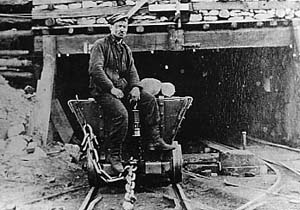
Welcome to the Sparwood Virtual Museum of Coal Mining. In the following pages, we hope you will learn more about the history of coal mining in the Elk Valley Crowsnest Pass region near the communities of Michel-Natal and Sparwood, British Columbia. Not only will you discover what coal mines were like at the beginning of the century, but also the importance of coal to the lives of people that continue to make Sparwood their home today. Much has changed during the past century, however coal has remained a constant. We invite you to take a glimpse into our lives – a glimpse we hope will inspire you to discover more about coal and the people who make it possible.
Natural History
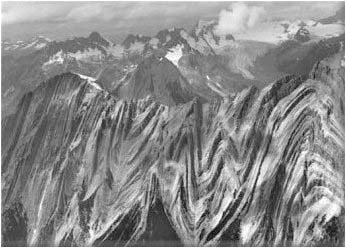
Coal, Coal, Nothing but Coal
Early travellers who visited the region noted the many natural outcroppings of coal;
Father Pierre Jean DeSmet, a Belgian-born missionary, travelling just to the West of Crowsnest Pass in 1845 wrote prophetically:
“the quarries and forests appear inexhaustible, and having remarked large pieces of coal along the river, I am convinced that this fossil could be abundantly procured. What would this now solitary and desolate land become under the fostering hand of civilization?”
Indeed he was not wrong, the coalfields of the Crowsnest contain reserves that run to the billions of tonnes and by the end of the nineteenth century their time had come.
What is Coal and How did it get Here?
Coal is sometimes called “buried sunshine” as it contains the energy from sunlight that fell on the vast forests and swamps that covered large areas of the world at various times in the geologic past. The coal found in the Elk Valley – Crowsnest Pass region began being formed around 135 million years ago.
As these trees and plants decayed, they formed peat bogs which, over millennia, were buried by soil and rock. As these sediments accumulated, pressure and heat transformed the peat into flat lying coal seams.
The formation of the Rocky Mountains changed the coal from simple flat lying seams into folded, faulted blocks that popped out on surface in a variety of orientations. The structural complexity presented both opportunities and challenges to the winning of the coal that continue to this day.
Human History
First Nations
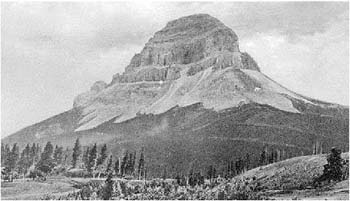
For over eleven thousand years, people have camped in and travelled through the Crowsnest Pass. A favourable climate, tempered by milder Pacific air masses, manifests itself in drier weather conditions, with less winter snow than locations even a few kilometres away.
The ancestors of the Ktunaxa First Nation migrating with the seasons and taking advantage of food-gathering and hunting opportunities, used the area as one of their main camps, returning to it repeatedly over the centuries.
After spending the winter in the fertile and productive valleys of the Kootenay and Columbia River systems and as the mountain passes cleared of snow, the Ktunaxa travelled through to the plains for a summer of bison hunting and berry gathering. These were eaten fresh as well as preserved by drying for later consumption. In the fall, re- supplied, the Ktunaxa journeyed back to the river valleys before winter snows blocked the pass.
European Discovery
As early as 1792, Peter Fidler, a Hudson’s Bay Company surveyor and trader – and the first European the Kootenays had ever seen – was told of the Crowsnest Pass as he approached the Rocky Mountains from the East.
Lieutenant Blakiston of the British-sponsored 1858 Palliser expedition, noted (not so optimistically) on an east-to-west pass called the “Crow Nest Pass: “By reports of the natives, it is a very bad road and seldom used”.
Setting the Stage
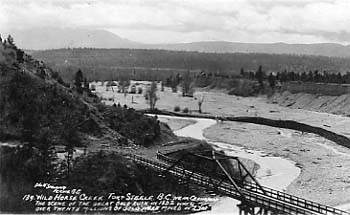
It wasn’t until the 1860’s goldrush at Wild Horse Creek northeast of present day Cranbrook that the Crowsnest again attracted attention. In 1873 Michael Phillipps, an ex Hudson’s Bay factor, while prospecting the Elk River Valley for gold, was disappointed to find only coal.
The summer of 1884 brought Geological Survey of Canada geologist George Mercer Dawson to southeast British Columbia. While Michael Phillipps had indicated the presence of coal, it was Dawson’s report that brought it to national attention when his work was released in 1886.
In 1887, Colonel James Baker a Cranbrook landowner, formed a syndicate with former Gold Commissioner William Fernie and others to develop the coalfields of the Crowsnest. By 1896 they had acquired 250 000 acres of coal lands and a provincial railway charter allowing construction of a line from the Elk Valley to the developing mines and smelters of the West Kootenays. There was only one problem – the railway had not been built and the markets were in danger of being lost to the Americans.
Mining Begins
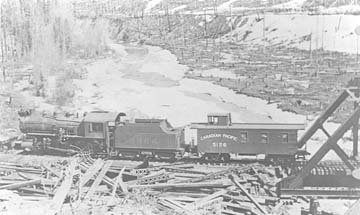
Help was needed and it came in the form of William Cornelius Van Horne, head of the Canadian Pacific Railway. Due to natural and economic disasters, Van Horne was in no position to finance the new line and in classic Canadian fashion lobbied for a government subsidy. Negotiations lasted for months and in 1897 the deal was done. Given a $11,000 per mile subsidy, CPR agreed to construct the railway. The Dominion Government secured lower freight rates from CPR (the “Crow Rates”) as well as 50 000 acres of coal land. Fernie and Baker agreed to develop mines and supply coal at reasonable prices.
Mining began late in 1897 when twenty miners from Cape Breton were brought to Coal Creek near Fernie. In that first year, 10,000 tons of coal and 361 tons of coke were produced in the field. By the end of 1898, the rail line was complete. As markets grew, the mines were expanded and more miners came to the Crowsnest.
Mining Coal – Economics
Steam Coal
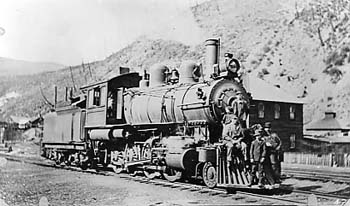
In 1900, coal was the fuel of home and industry and a key to industrialization. Coal produced in the Crowsnest Pass mines was a high quality bituminous coal. When burned, it produced little ash and was very good for generating steam in locomotives and power plants.
It was used extensively in steam locomotives on the Canadian Pacific and also by the Great Northern.
Coal was also used in steamships, as a domestic fuel for home heating and to power industrial machinery in sawmills, mines, mills, smelters and factories.
Coke Manufacturing
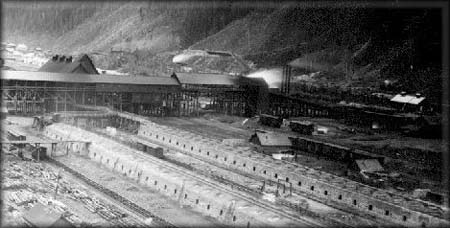
Smelters didn’t use coal directly, but used coke – a carbon-rich, gray, porous material produced by roasting coal in large banks of coke ovens at temperatures of about 1000 degrees Celsius for about 48 hours.
Major coke manufacturing facilities in the Crowsnest Pass were located at Fernie, Michel, Morrissey and Hosmer in British Columbia and at Lille and Coleman in Alberta.
Crowsnest Pass coal was an excellent coking coal and superior to the coal mined on Vancouver Island for this purpose. On average, it took about 1.43 tonnes of coal to produce a tonne of coke.
Coke Ovens

In the early years of the Crows Nest Pass Coal Company, much of the profit was immediately re-invested into coke ovens. Every year, the Company’s annual report heralded new ovens coming into service.
It wasn’t long before Michel had more ovens than any other mining operation in the region – 464 to be exact. These beehive ovens were in use until they were demolished in 1952.
Fifty-two more modern ovens continued to be used until the early 1970’s.
The Coke Market
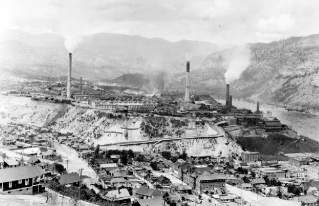
The coke was loaded into open gondola cars or boxcars and shipped by rail, initially to smelters in Nelson and Trail, and to the Northport Smelter just over the American border.
The production of coke depended to a great extent on the market demands for it. For example, in 1904, 350,900 tonnes of coal – 54 percent of total production from the British Columbia mines in the Crowsnest, was made into coke.
It didn’t last – in 1922 after the closure of the smelters at Grand Forks and Greenwood, only 61,497 tons of coal or 11 percent of production, was made into coke.
Coal Production
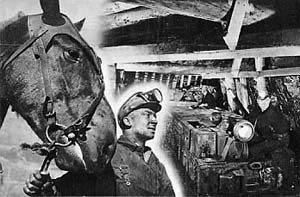
Coal production peaked at 1.5 million tonnes in the years before the First World War and slowly declined, with some fluctuations, over the next forty years.
An industry in decline attracts little new investment and the mine operations became outdated, facilities were not renewed, and the mining towns of the Crowsnest suffered.
By 1959, annual production hit an all-time low of only 850,000 tonnes, and the British Columbia coal industry faced virtual extinction.
Decline of Coal Mining
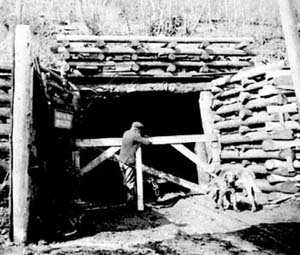
Many factors contributed to coal’s loss of importance but the most significant was the growing use of petroleum products for fuels. Also, British Columbia did not have a steel making industry, which required large quantities of coal.
Railways converted many of their steam locomotives to burn oil and in the 1950’s, they disposed of all steam equipment in favour of new diesel locomotives. Oil also became popular in home heating and industry.
At the same time, hydro-electric power was growing in popularity and availability for both industrial and domestic uses.
Rebirth
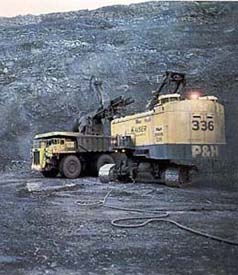
As traditional markets disappeared in North America, coal producers looked elsewhere for markets. In the early 60’s, the Crows Nest Pass Coal Company began shipping small test shipments to Japan for use in steel making. These tests were successful and in 1968, contracts were signed that led to the resurgence of coal mining.
Now than the markets had changed, California-based Kaiser Resources purchased the mining rights of the Crows Nest Pass Coal Company and more fundamentally, the mining method changed from underground to surface mining.
Modern Surface Mining
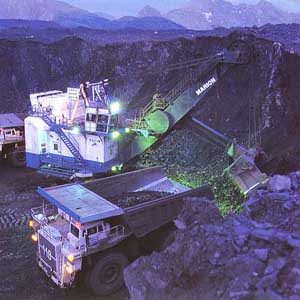
Coal mining has changed from small, dark dangerous workings where one miner worked the coal with a pick and shovel, to large, highly mechanized open pit mines. Huge trucks and shovels move more coal in one shift than could have been ever imagined in the old days.
Working in the open fresh air, mining is no longer the dangerous occupation of old. Computers, satellite Global Position Systems, and all manner of advanced technologies help to make the modern-day mines of the Elk Valley some of the most efficient and safe industrial operations in the world.
Coal Today and in the Future
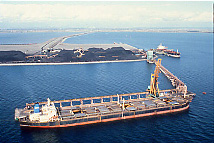
Coal is the world’s most abundant fossil fuel and is second only to oil as an energy source. Economically mineable reserves exceed one trillion tonnes – enough to last over 200 years at current rates of consumption. By comparison, current reserves of oil will last 45 years and natural gas 70 years.
Unlike oil and gas reserves that tend to be concentrated in specific regions, coal is widely distributed. In some regions, coal is the only realistic option as an energy source due to factors of availability and economics.
Coal is also one of the largest commodities moved by ships worldwide.
Mining Coal – Methods
History
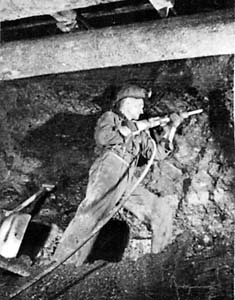
Historically, underground methods were used to mine coal. When a coal seam was to be mined, a tunnel was driven to access the coal. Branching off this main tunnel were smaller tunnels that ran in the coal seam and allowed it to be mined. As time and mining progressed, each mine consisted of many miles of these workings.
The earliest mines were usually worked largely by hand; the miners’ using picks and shovels to dig and load the coal into one ton coal cars. “Pit ponies” pulled trains of coal cars on rails to surface, though in some, the miners pushed the coal cars themselves.
These techniques were inefficient and by the 1900’s, mechanization was becoming common in coal mining, although in some mines, to reduce chances of sparks and explosions, hand mining continued for many years.
Miners and Their Equipment
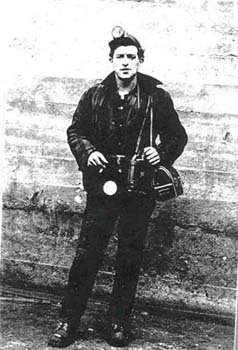
A miner’s equipment was simple. The mines were usually cold, damp and often very wet – so miners needed warm clothes, heavy boots and a cap. In the early days, there was little protective clothing or safety equipment but after the Second World War, the miners used hard hats and steel-toed boots.
Picks and short-handled shovels were used extensively underground for digging and loading the coal. Hand augurs or drills were used to make holes for the charges of explosives used to blast out the tunnels or waste rock and to loosen the coal from the face of the workings. In many areas blasting was used sparingly because it broke up the coal and produced large quantities of coal dust.
By the early 1900s, compressed air drills and coal cutting machines were increasingly important in the underground mines and in later years, conveyors and underground loaders were used.
Underground Mining
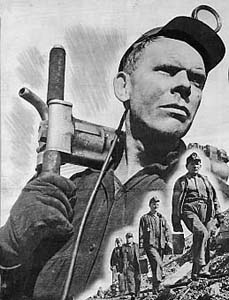
There were two types of underground mining used in the early mines of Michel-Natal. The most common techniques were “pillar and stall” and “long wall” mining. These were traditional techniques had been used in Europe long before the development of the mines here.
Pillar and Stall
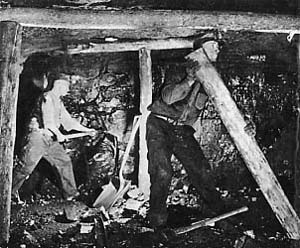
In pillar and stall workings, coal was removed from large areas underground, but much of the coal was left behind. These were the pillars that supported the roof of the mine and normally prevented the mine from caving in as the miners cut deeper into the coal seam. Sometimes these pillars were removed after the main parts of the seam had been extracted.
Tunnels and workings also required timbers or “pitprops” which supported the rocks above and prevented smaller rocks from falling onto the miners.
Long Wall
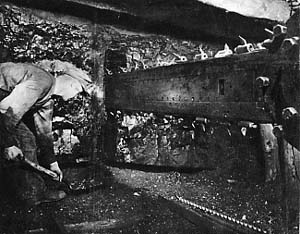
Long wall mining worked in a different way. Tunnels were dug into the coal seam, usually supported by pit props and pillars of rock, and then miners worked along face of the coal seam removing coal as they worked.
Timbering was carried out along the areas being mined but the area in behind from which the coal had been mined was allowed to collapse.
Long wall mining was usually done on thin coal seams up to about 5 feet (1.5 metres) in thickness.
Underground Railways
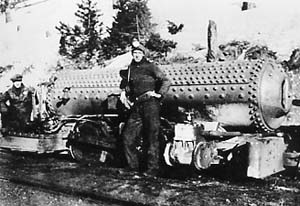
Coal was moved from the workings to the surface by underground railways. When mining started here in 1898, small spark free compressed air powered locomotives or “dinkys” were used to haul trains of one ton coal cars to surface.
Steam locomotives could not be used underground because of the danger of their fires starting an explosion. Electric locomotives were seldom used in the early mines and only in areas that were completely free of explosive gases.
As time passed and technology advanced, the railways were replaced by electric powered loaders and conveyor belts.
The Tipple
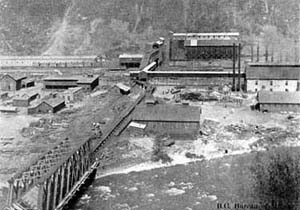
In the early underground coal mines, the most obvious structure at the mine site or “pit head”, was the tipple. These structures processed the coal into different products and were were usually built on a railway siding so that the coal could be loaded into railway hopper cars for shipment.
The picture shows the Michel Tipple in 1909.
Mining Coal – Costs
Poisonous Gases
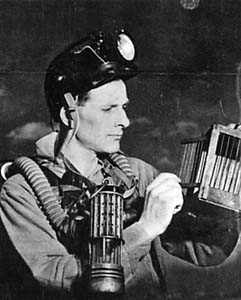
Underground coal mines were dangerous places to work. The miners not only had to contend with the cold, dark environment with the constant danger of falls of rock, but also with the air they breathed. Coal contains methane gas, which is released when the coal is mined. A tremendous amount of methane was produced in the Crowsnest mines. A study from the 1920’s estimated that 3,640 cubic feet of methane gas was given off for every ton of coal produced.
Known by the miners as firedamp, methane, when concentrations become high enough, is highly explosive – the slightest spark could set it off.
The very fine coal dust produced by mining also posed a danger – it was usually the combination of methane and coal dust which caused explosions that killed hundreds of miners in the Crowsnest coal field over the years.
Ventilation
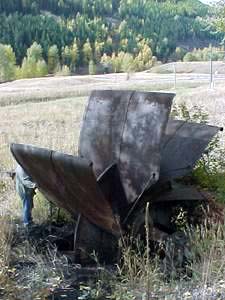
Breathing fine coal dust over many years could lead to a disease known as pneumoconiosis of coal miners or “black lung.” The disease progressed from causing coughing and minor lung impairment to progressive loss of lung capacity, increasing disability, and possibly death.
To counteract this reality, the mines installed large ventilation fans built at the surface which were used to draw air out of the mines to make sure there was fresh air for the miners to breath and keep the levels of explosive gases to a safe level.
In the Crowsnest mines, ventilation fans, depending on the size of the mine, could deliver from 30,000-180,000 cubic feet per minute to the workings.
The remains of one such fan is shown above.
Mine Rescue Teams
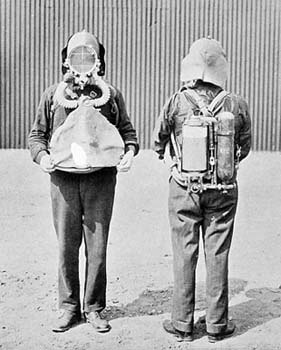
Because the mines could be so dangerous, mine rescue teams were trained at the mines. These men took courses in techniques for entering mines following explosions, cave-ins or other accidents. Each mine rescue team member was normally equipped with special breathing apparatus and other safety gear. Mine rescue teams became highly proficient in their work and took great pride in their skills.
It was highly dangerous work because they could never be sure if there would be other explosions or cave-ins after they entered a mine. There might be pockets of poisonous gases that could kill them in minutes.
Many miners owed their lives to the swift work and fearless response of the mine rescue teams.
Mine Rescue Competitions
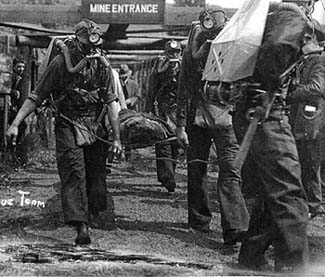
Mine rescue teams trained and practiced to make sure they were in top form in the event of an accident. Teams from different mines and different working shifts competed for championships and trophies.
The rescue teams were held in high esteem by their fellow miners and the people of the mining communities.
Michel-Natal – Beginnings
The Miners Arrive
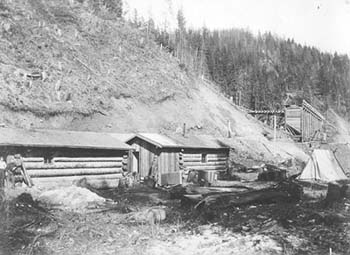
There had previously been little reason for people of European origin to come to the Elk Valley, however with the coming of the railway and the mining of coal, they came in droves to a country where only the Ktunaxa had been before.
Once the companies began to exploit the coal, it would change the physical and social landscape of the Elk Valley forever.
Creating Communities
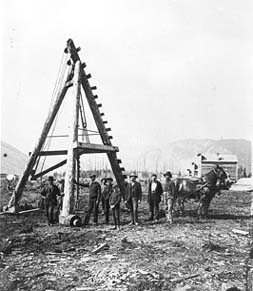
Coal mining may have brought people to the Crowsnest to mine coal, but they also built homes, lives and created communities for themselves and their families.
This image shows the first stage in preparing lots for house construction – pulling stumps.
Community Spirit
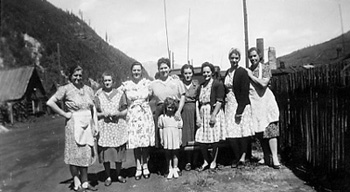
The importance of community spirit should not be overlooked in understanding the pride and happiness former residents of Michel-Natal still feel when discussing the “good old days”.
Community spirit also played an important role in the culture of the twin communities – it offered a means for the citizens to forget about the stresses and hassles of living in a coal-mining town. It also forged a distinct identity, made up of a sense of pride and closeness with their often times dirty and smoky hometown.
Though the buildings of Michel-Natal may be gone, the community spirit built up in the early years survives to this day.
Celebrations
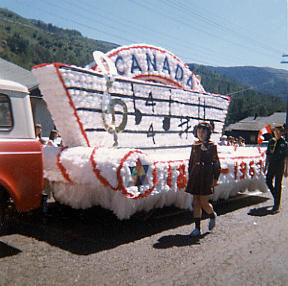
Community spirit manifested itself in many ways in Michel and Natal, especially during special holidays or celebrations. During Halloween, for example, many parents wore costumes of their own as they accompanied their children on trick or treat rounds. Although they rarely received candy, these adults enjoyed challenging people to guess who they were.
At Christmas and Easter time, suppers and dances were a tradition, and were usually put on by the local clubs or churches.
Dominion Day (July 1st) was the most obvious time that community spirit was openly and actively displayed by residents. Citizens worked hard to make the Dominion Day parade as flamboyant and as entertaining as possible.
Dominion Day
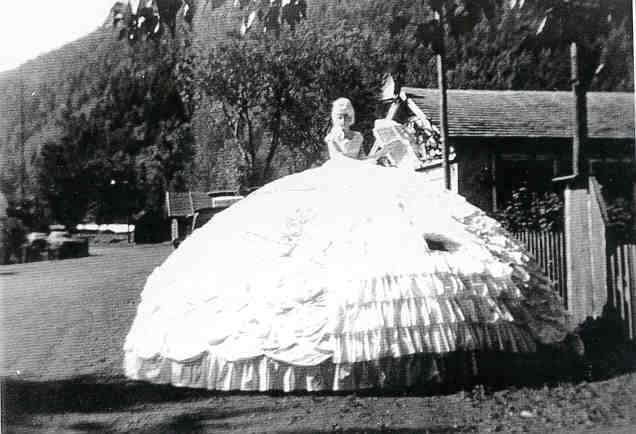
Decorating floats weeks, sometimes months in advance, many clubs, businesses, and even just groups of friends sought to make the parade exciting not only for children, but for adults as well. A Miss Dominion Day pageant was also a regular attraction during the celebrations, with local clubs each backing a young contestant.
The pageant was judged not on the beauty or talents of the contestant, but rather on how much money she raised with the help of the organization that sponsored her. Proceeds from the event would go towards worthwhile causes, and the contestant who raised the most money was proclaimed Queen.
All of the participants were bought a dress and outfit from the club that supported her, and each young lady would ride in a “royal” float designed especially for the contestants.
Other Places
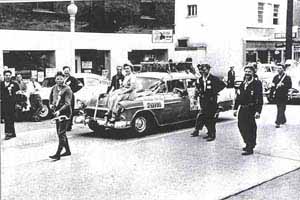
Michel-Natal residents did not just participate in local parades, but in parades in other communities as well. In the picture, several residents march in a parade in downtown Fernie.
The Michel-Natal band took it a step farther as this photo of them taken at the 1944 Calgary Stampede Parade illustrates.
May Day
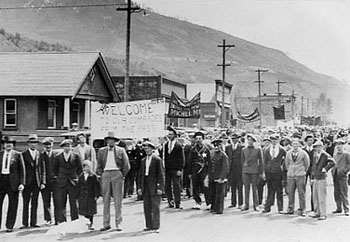
May 1st or “May Day”, was a holiday like no other for miners and their families in the Elk Valley. Proclaimed as International Worker’s Day at the founding meeting of the Socialist International in 1889, May Day was a day of solidarity and celebration.
Never a statutory holiday, its celebration in Michel-Natal recognized the dangerous working conditions and iron-fisted control of the miners lives by the coal company and the belief that a secure future lay in socialism.
Organized by the miners local unions, the day’s events usually included a parade, speeches by working class leaders, performances by the Michel-Natal Band, and activities for children.
Michel-Natal – The People
Women In the Community
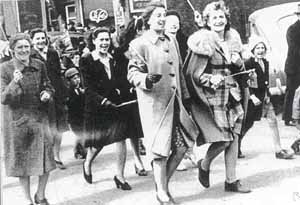
Women, by investing their energy, interests, and skills, helped transform Michel-Natal into thriving, multi-faceted communities. Some would say it was a survival instinct that aroused in women the need to offset the stress of mining life with a feeling of community spirit. This section is a tribute to the many women who called Michel-Natal home between 1897-1971.
Typically, women’s subtle and not-so-subtle contributions have gone unmarked. Indeed, their varied roles, from supporting the men in the mine, to working as employees at the various jobs and businesses that kept the twin communities running, were not undertaken for recognition but for the sake of creating a home and a community.
Women made a variety of contributions to Michel-Natal. Oftentimes the leaders in encouraging community spirit in the area, the women of Michel-Natal were instrumental in organizing parades, bazaars, and spaghetti dinners. Even during difficult times, such as a funeral or a mine disaster, the women of the community banded together to make meals for the mine rescuers or grieving families.
Women In the Home
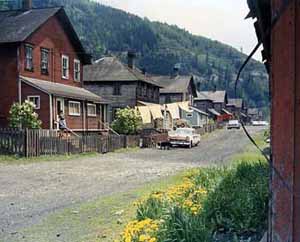
Women were instrumental in maintaining the households, particularly with the constant entrance of dust, soot, and smoke into the houses. Situated within a narrow valley, Michel-Natal sat between two mountains which were each being actively mined first by the Crowsnest Pass Coal Company, and later Kaiser Resources.
Though Michel-Natal homes faced a never-ending barrage of dust and soot, citizens literally took pride in having immaculately clean homes on the inside. Living in such a dirty environment, the women of Michel-Natal took extra pride in maintaining a high degree of cleanliness in their homes and buildings.
The Michel Hospital in particular had a reputation as having a spotless, pristine interior. The nurses, matrons, and cleaning staff of the Michel Hospital were constantly commended for keeping the dirt out.
Clubs in the Community
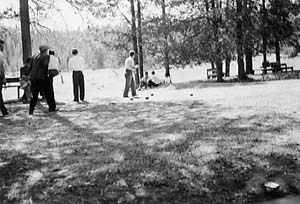
The various clubs and organizations of Michel-Natal played an influential role in promoting community spirit. One major function was organizing various social events for the community. Local clubs or organizations almost always organized bingos, spaghetti suppers, picnics, bazaars, and dances. The lodges in particular were quite instrumental in assisting various sports leagues in the area, often helping organize minor league baseball or soccer tournaments.
Without TV’s, computers, stereos, and other distractions, these club-organized events provided a great deal of excitement amongst local citizens, who very much looked forward to any opportunity they could get to leave the house and socialize. The small size of the two towns made it far easier (and cheaper) to orchestrate such events for any resident who wished to attend. The Italian Lodge in particular held bi-monthly and annual picnics that proved to be highly entertaining, with events like bocci and horseshoe tournaments being the main attractions.
Charity Fundraising
Another important function of the clubs and organizations was to raise money for worthwhile causes in the community. Many of the social events were carried out as endeavours for charity or for a local cause. Money raised from these events would be given to such charities as the Canadian Cancer Society or the Heart and Stroke Foundation.
Quite often, money was also raised to improve the community – most notably for such local institutions like the Michel Hospital or the Arena.
Meetings
Interestingly enough, the general meetings of Michel-Natal’s clubs and organizations served a unique purpose in and of themselves. The meetings served as weekly social gatherings of club members that gave citizens a specific reason to go out on a weeknight to socialize.
Of course, important business would be discussed at the meetings, but that never stopped members from getting together after the meeting to enjoy each other’s company at one of the many “establishments” the twin communities had to offer.
The Royal Antediluvian Order of Buffaloes, for example, met in the basement of the Michel Hotel, and after each meeting they would naturally go up stairs for a few “cold ones.”
Ladies Clubs
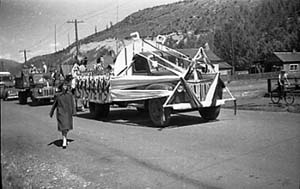
Ladies clubs were immensely popular with not just housewives but also working women who enjoyed the opportunity to get together with their peers and help out the community.
Their function was identical to the men’s organizations and their contributions equally beneficial to the citizens of Michel-Natal.
The more prominent women’s clubs in the area were usually closely affiliated with the churches in the community, but many, like the Rebekha’s, existed independently.
Changing Times
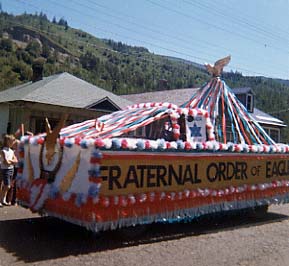
Unfortunately, many of the clubs and organizations of Michel-Natal disappeared with the relocation of the twin communities to Sparwood in the late 1960’s. Sadly, some of the oldest clubs in the area, such as the Buffaloes and the Oddfellows, were disbanded at the time of the move and never re-established. Many of the ladies clubs, such as the Catholic Women’s League and the Mount Carmel Society still meet regularly, organizing bazaars, bake sales, and craft fairs.
Part of the problem was that many citizens spent the early part of the 1970’s building their new homes and lives in the suddenly booming Sparwood region, while other former club members left the Elk Valley region altogether. In addition, the large influx of new workers and their families who came to the area took away the close-knit familiarity that Michel-Natal residents felt towards one another.
Not all of Michel-Natal’s clubs died with the two towns – the Eagles, founded in Michel in 1909, remain an active part of Sparwood today.
Michel-Natal – Sports
Leagues
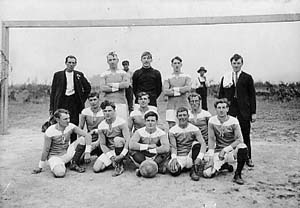
Sports and Sports Leagues also played an important social role in Michel-Natal. Soccer, baseball, and basketball were the most popular sports, and Michel-Natal certainly had their fair share of “popular” teams.
Michel-Natal’s population simply did not allow for local leagues, like the numerous softball and soccer leagues in Sparwood today, but local sports enthusiasts always managed to find a sports league of some kind either in the East Kootenay or the Crowsnest Pass to play in.
Soccer
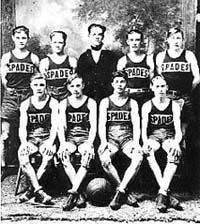
Soccer was the longest played sport in the area, beginning as early as the late 1890’s in the Michel Football Field. Soccer was a gritty, dirty, and aggressive sport, with the most active participants of the game being rugged miners of English and Italian descent.
One of the most famous soccer teams in Michel’s history was the 1935 Michel Football Club, who won the Graham Cup East Kootenay Championship.
Baseball
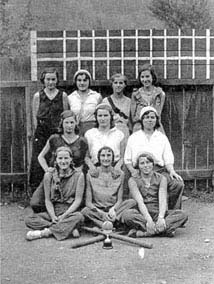
Baseball was a popular summertime sport and was played by men, women, and children alike. Baseball games and tournaments were immensely popular spectator sports, and ironically in and of themselves, turned out to be as much of a recreational event for the fans as they were for the players. Many ladies, for instance, attended the games not just to root on their team (they played in a league of their own), but rather to socialize with their friends and fellow townspeople.
Softball only began to be played in the late 1960s, and many old timers today humourously scoff at the younger generations who regularly play softball in Sparwood. “If we ever played softball in Michel-Natal,” mused one old timer, “we’d hit that dang thing out of the park. Who couldn’t hit a ball the size of a grapefruit!?”
Basketball
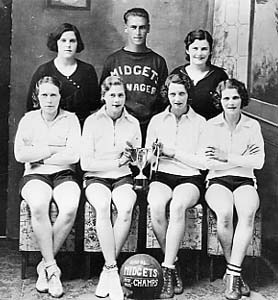
Basketball didn’t enjoy much of a following until the 1930’s and 40’s, and then skyrocketed as a popular team sport. The tiny United Church Hall was the only place where the game could be played so most who participated were in the local leagues set up to use the hall.
Women’s basketball teams were quite prominent – the Natal Midgets, shown here, went through the entire 1932-33 Crowsnest season undefeated and went on to win the championship that same year.
The most famous men’s basketball team in the area was the Natal Pirates, who won 46 consecutive games in the Crowsnest League in the 1943 season, shattering the previous mark by five games.
Hockey
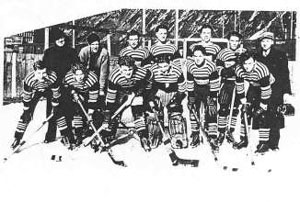
Hockey was also a popular, though too expensive for many, sport in the twin communities. The Michel Outdoor Rink was the site of many scrimmages for local citizens, and even had games in the 1920’s and 30’s, when Michel teams would participate in the Crowsnest Ice Hockey League.
The Natal Rink eventually replaced the Michel Outdoor Rink as the main centre for hockey, figure skating, and broomball.
The Move to Sparwood
A New Life
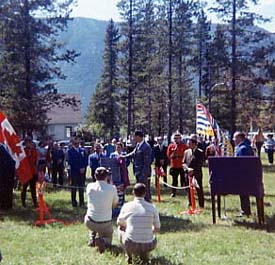
“Michel-Natal no longer stands,
Where did my home town go?
No houses, friends, not even streets,
God is this truly so?”
– Arlene Gaal, former Natal resident, entitled Michel-Natal
“Oh God, by whose word all things are made holy, pour down thy blessings on this new town of Sparwood.”
– Father Leslie Trainor, official opening of Sparwood, June 21, 1970.
This picture recording the opening ceremony is similar to many official unveilings – the story behind it is not.
The Announcement
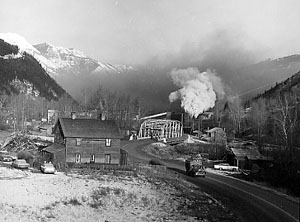
The beginning of the end for the twin communities of Michel-Natal started in the early 1960’s with the now infamous rumour that an anonymous British Columbia cabinet minister, after driving through Michel-Natal from Alberta, declared that the twin communities represented a dirty and deplorable entranceway into B.C.
The rumour to this day remains unsubstantiated, but in 1964 a controversial announcement was made by then BC Minister of Municipal Affairs Dan Campbell, that a joint venture was being undertaken by the federal and provincial governments to relocate Michel-Natal westward to a small hamlet called Sparwood.
The main motivation behind this study was to improve the health and living standards of Michel-Natal residents by relocating them to a cleaner locale. However, it was also clear that the provincial government in particular was also interested in promoting British Columbia’s tourism industry, and that the coal-dust laced buildings of Michel-Natal did not represent an ideal entranceway into the province.
Early Days
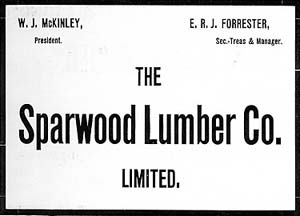
Sparwood was by no means a new community in 1964, nor was it a creation of the federal or provincial government. Sparwood had existed in the Elk Valley as early as the turn of the century but was never anything more than a few houses and a lumber mill. In 1939, the village was officially surveyed by the Crows Nest Pass Coal Company and special homes were built there for the mine’s managers. In the 1940’s and 50’s, Michel-Natal residents were pressured by the Coal Company in particular to build homes in Sparwood. Many residents chose to stay because the older homes that they were already living in offered not only cheap rent, but also the familiarity and comfort of friends and family.
Those employees who did leave took comfort in the fact that Sparwood was well out of the way of the dust and grime, but still only 6 km from the mines, so they could easily travel to and from work.
The Relocation
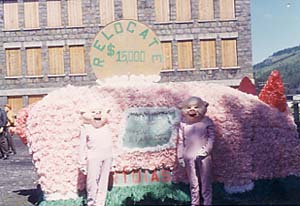
After the shock of Dan Campbell’s 1964 announcement had sunken in, many of Michel-Natal’s citizens began to welcome the idea of relocating their homes away from the mine’s shadow. Provided that they could get a good deal for their homes, these citizens felt that they would actually enjoy the cleaner area. Maintaining their home’s interior was challenging enough, but maintaining the homes exterior that was continuously sprinkled with coal dust was a hopeless venture. Indeed, the notion of living in an immaculate, brand-new home was an exciting prospect for most residents. A 1965 plebiscite revealed that 95% of the residents were in favour of the move.
Kaiser Resources

Further complicating the relocation situation was the change in ownership of the coal company. In 1968, California-based Kaiser Resources purchased the mining rights of the Crows Nest Industries Elk Valley mining operation.
Kaiser Resources wanted the land that the twin communities sat on in order to stockpile equipment and to create offices and warehouses for its new strip-mining operation. Of course, that meant that many of the homes and businesses that had existed in the area for so long would have to be demolished in order to make room.
Those residents who could not afford to make the move to Sparwood, or who did not want to abandon their homes in Michel or Natal, were now compelled to either make a stand or lose their property altogether.
The Deadline
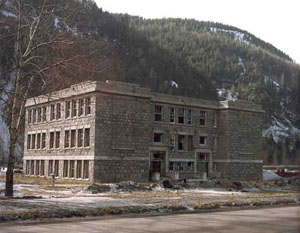
As many people left to create a new life in Sparwood, those who stayed faced an uncertain future. Kaiser Resources and the Provincial Government set a series of deadlines after which demolition crews would be sent in to tear down those houses and buildings that could not be transported to Sparwood.
The last few steadfast occupants who refused to leave their residences faced the ultimate prospect of having all of their water and electricity cut-off. By 1971, only a small handful of people lived in the area.
In 1978, with the demolition of the once impressive cobble-stoned Michel-Natal School, the twin communities became nothing more than a few abandoned buildings.
X’s and O’s – Winners and Losers
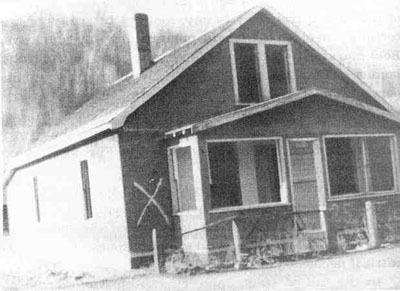
Perhaps the biggest tragedy of the relocation of Michel-Natal is what has been lost forever. The crews who demolished the towns did so in a manner that still makes many former residents cringe whenever they reminisce about the event. Unfortunately, preserving any sort of heritage from Michel-Natal was the farthest thing on the minds of the people instrumental in tearing down the twin communities.
The notorious “X’s and O’s” spray-painted on the homes provide bitter last memories for those whose whole lives had been spent in the twin communities. An “X” placed on a building signified that it was to be torn down, while the “O” provided the building with “a second life” – it could be transported to Sparwood – albeit at a rather high cost to the owner.
Only One Remains
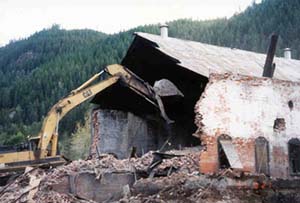
Unfortunately, with the recent demolition of the 1907 and 1908 twin powerhouses in 1997, virtually nothing stands in the valley where two very active and enthusiastic communities once existed.
Returning former residents who had left the area altogether following the relocation are now greeted only by the lonely Michel Hotel. Besides the hotel the only physical evidence remaining of Michel-Natal’s existence are sod-covered slack piles and moss infested fire hydrants; ghostly, vague, and unfitting reminders of once vibrant and dynamic neighbourhoods.
The Bitterness
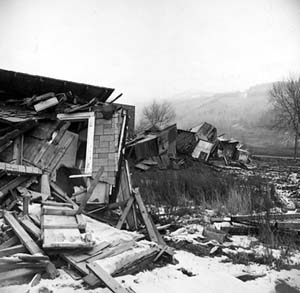
To this day, the relocation remains a bitter pill to swallow for many former residents of Michel-Natal. The reason for this bitterness lays not so much with the theories behind relocation, but rather with the way it was carried out. Many inhabitants to this day insist they were promised a brand-new house in exchange for their old Michel-Natal home. The reality was that when their houses and businesses were actually assessed, they were deemed to be far below the value required to make a one-for-one trade on a new home. Moreover, those residents who were not affiliated with the Coal Company in any way received no financial compensation for their homes.
As one District official aptly stated, “the organizers of the urban renewal project treated everyone like a statistic rather than consider the human needs of special social classes.”
The Future
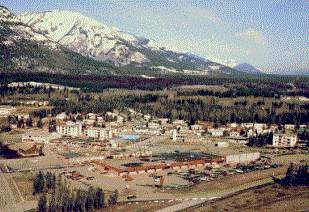
The “official” townsite of Sparwood opened on June 21, 1970. It received blessings not only from Father Leslie Trainor, the popular Natal Catholic priest, but also from Orlando Ungaro, the former mayor of Natal who carried out many of the relocation negotiations with the provincial and national governments in the late 1960s.
Sparwood continues to thrive today – the recent addition of the Terex Titan truck draws in thousands of tourists into the community each year. In addition to the Titan, other attractions like the ski hill, heritage murals, golf course, and leisure centre keep both citizens and visitors entertained.
Coal mining continues to be the mainstay in the area, employing over 60% of the town’s active workforce – a tradition that has remained a constant even with the passing of Michel-Natal, where the very first miners of the area made their homes over 100 years ago.
In Memorandum
Supporting the Family
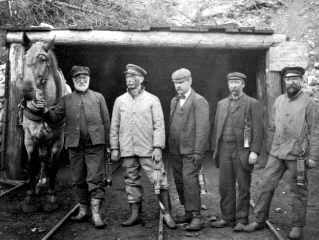
Mining the Elk Valley’s mountains was a difficult and oftentimes dangerous undertaking for the courageous men of Michel-Natal and Sparwood.
The mines were unquestionably the economic backbone of the Elk Valley region, and for many of the veterans who toiled underground, in the coke ovens, or on the surface, the arduous work within the mines was the best – and at times the only way to support a family.
The Black Hole of Calcutta
The biggest challenge to underground mining was the working conditions one had to tolerate when inside the mine. The straight and narrow mine shafts made it difficult for the miners to manoeuvre around in.
The lack of light within the mountain itself made it difficult for the miners to see where they were going. There also existed the possibility of one’s light burning out deep inside the mine and getting stuck in complete darkness.
“I was in the furthest part of the mine [and] my light went out and I’ll tell you if you ever see the black hole of Calcutta, if you’ve ever heard of that, well that’s where I was.
I practically had to crawl on my hands and knees feeling along the rail, travelling along the different seams and intersections [of the mine]. They were like veins shooting out in different directions.”
– Paul Chala, Michel Underground Miner, 25 years.
Working Conditions
The air inside of the mines was often cold and dry; however on days when there was very little air flowing through the ventilation shafts, the inside of the mine would get warm and humid.
It was often very dusty in the various shafts and adits that comprised the underground mine, and in a workday the average miner would inhale not only a sizable amount of rock dust, but also considerable amounts of blasting smoke and carbon dioxide.
On the days of excessively poor air flow throughout the shafts, the miners were literally compelled to breathe in the pollution.
Falls of Rock
Although the environmental conditions inside the mine often made the coal miner’s work more difficult, the concerns of most workers centered around the potential dangers they had to be aware of constantly. One of the biggest threats to the safety of the miners was falling rock. Quite often, during a workday, the mountain would rumble and a few slabs of rock would fall to the ground just to remind the miners to stay alert with one eye up to the ceiling.
“You’re about two miles inside and every one in awhile you’d hear the mountain rumble and see a few slabs of rock would fall and sometimes hit your hard hat…I can really sympathize with these old timers who worked twenty, thirty years in the mine…They’ve got to be a special breed of people.”
– Summer Student Working in Michel Mines
Gas and Dust
Another significant hazard was the danger of inhaling methane gas, which felt like a burst of fresh air hitting one’s face.
“Mining then is nothing like it is today… in the old days, you had to eat lots of gas, lots of dust, blasting with powder you ate powder smoke and you couldn’t see for hours and you wonder why guys after working thirty years had bad lungs and everything else.”
– Angelo Pascuzzi, Former Michel and Balmer North Underground Miner
Explosions
While the dangers of falling rock and of getting stuck in the dark, remained a steady concern. The biggest fear of the underground miners of the Elk Valley was far and away the fear of getting killed in an underground explosion, which tragically happened to 146 Elk Valley miners in the twentieth century.
Facing constant danger, the miners nevertheless returned day after day to the pits, hoping that at the end of their shift, they would again see their families and friends.
The following pages are dedicated them – the courageous miners of Michel, Natal, and Sparwood who paid the ultimate price in pursuit of the Elk Valley coal.
January 9th, 1904
No. 3 Mine – Michel Colliery – A gas explosion killed seven miners and injured two, likely caused by an over-accumulation of methane gas in one of the cross-cuts on the west side of the mine. The possible source of ignition was an open-flame from either a shot-lighter or match. This caused the Crows Nest Coal Company to more vigorously enforce an already existing policy banning matches from the mines.
The Fallen
| William McAllister John Micone William Roberts Jack Sale | Thomas Evans George Blake Robert Lee |
August 11th, 1916
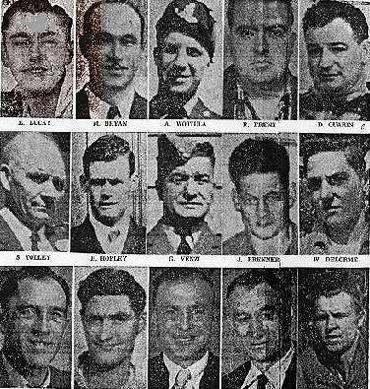
New No. 3 Mine – Michel Colliery – A gas or suspended coal-dust explosion killed thirteen men and caused extensive damage to not only the mine but to the townsite of Michel as well. The explosion’s detonation was believed to be caused by a lighting strike on one of the car rails that led into the mine. The aftermath of this tragedy marked the first time that the Crows Nest Pass Coal Company provided compensation to the dead miner’s families.
The Fallen
| Thomas Phillips Joe Mekus Hugh Evans Mike Marmol Oscar DeVolder Camilo DeVolder Andro Ficon | David Davies Thomas Hampton Dan Hall Sam Dmytriv Peter Hrbka George Kometz |
July 6th, 1938
“B” Seam, Michel Coliery – A suspended coal-dust explosion that killed three men but potentially could have killed far more were it not for the fact that the blast occurred on an idle day for Crows Nest Coal Company Employees. Like the 1916 explosion, the 1938 blast was believed to be caused by electrical flashes that entered the mine along a mine car rail and subsequently ignited a package of suspended coal dust. Following the catastrophe, the Crows Nest Coal Company properly grounded all railways that entered its mines.
The Fallen
| Edward Morrison John Phillips | William Cartright |
April 3rd, 1967
Balmer No. 1 (Balmer North) – Michel-Natal’s worst mine disaster killed fifteen miners and injured ten more. The coal-dust explosion was initiated by a spark from a rock fall in an unused, unventilated gob that developed a considerable accumulation of methane gas. The dust and debris from the explosion travelled well into the Michel and Natal townsites and damaged several buildings. Perhaps the most tragic aspect of the disaster was that in the days and weeks prior to the explosion, several of the workers speculated that the mine would “one day blow.”
To learn more about this devastating disaster watch Balmer North, 50 years later.
“We said every day, we go in but we’re not sure if we’re coming out. We knew it was gonna be happening…There was too much dust.. .A mine is a mine. You go in, you never know if you’re going to come out.”
– Pete Rotella, Balmer North Survivor.
The Fallen
| Michael Bryan Hugh Hopely Eric Lutzke Guy Venzi Eugene Lucky John Brenner William Cytko Walter Gibalski | Delfie Quarin Tony Capeliaskas Walter Parker Willie DeLorme Sam Tolley Archie Wojtula Ronald Freng |
June 19th, 1969
Balmer No. 1 (Balmer South) – A bump caused a substantial cave-in and flood deep within the mine that killed three miners and left three more trapped underneath 600 feet of rock for over 80 hours. The bump let loose water that had accumulated in an old working, and resulted in the drowning deaths of the three victims. Miraculously, the men who were trapped were found alive by dedicated rescue workers who worked around the clock much to the relief of their families and the citizens of the Elk Valley.
The Fallen
| Steve Tkachuk Robert Dancoisne | Jerry Health |
Glossary
Adit
A small scale tunnel drilled into a coal seam for prospecting purposes. Used by miners to collect samples to determine the coal’s properties.
Bituminous
A high quality coal that produces little ash when burned and is therefore good for steam generation in locomotives and power plants.
Bump
A natural settling of the earth, caused by gas release within the earth’s crust – quite common in underground coal mines.
Coal Seam
Descriptive term for individual layers of coal found in the geological strata.
Coke
A hard, dry carbon substance produced by heating coal to a very high temperature (1000 degrees Celsius) in the absence of air. Coke is used in the manufacture of iron and steel.
Coke Ovens
Used to bake coal to make coke. Turn of the century ovens looked very much like beehives and were thus often referred to as beehive ovens.
Cross-cut
A cutting that intersects the main workings.
Factor
The manager of a trading post or ‘factory’.
Gob
An underground working from which all of the coal has been extracted, sometimes closed off from the rest of the mine.
Ktunaxa
The name by which the aboriginal people of Southeast British Columbia know themselves. It is pronounced KT-OO-NAH-A. The Ktunaxa first nation continues to be a significant and vital part of life in southeastern British Columbia.
Metallurgical Coal
The type of coal which is converted to coke for use in manufacturing steel – often referred to as coking coal.
Methane Gas
Formed during the decomposition of organic matter in the absence of oxygen. In the case of coal, this decomposition took place when the coal was being formed.
Peat Bogs
A dark brown or black deposit resulting from the partial decomposition of vegetative matter in marshes and swamps. Precursor to coal.
Safety Lamp
A special lamp for use in areas where explosive gases may be present. As used in the old-time mines, this means an enclosed flame lamp with a special filter to prevent the ignition of methane or coal dust.
Tipple
The building near the mouth or entrance to the mine where the coal is taken for initial processing, sorting and loading.
Workings
General term used to describe the areas in which coal is being mined.
Biographies
Michael Phillipps
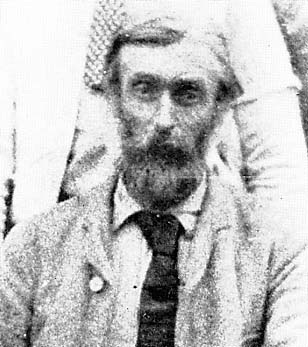
Courtesy – Backtracking with Fernie & District Historical Society
Michael Phillipps, one-time Hudson’s Bay Company trader at Tobacco Plains, arrived in southeastern British Columbia just as the placer-mining camps were opening, in 1864. After leaving “the service” in 1869, he remained in the area where he trapped, prospected, and occasionally, worked for the Provincial Government. His greatest fame derives from his record of the first European use of the Crowsnest Pass. Of the utilitarian routes through the Canadian Rockies, the Crowsnest is the only one which was first traversed and opened from West to East.
Phillipps first visited the upper waters of the Elk in 1873, with John Collins. They were prospecting for gold, and to their great disgust, found nothing but coal. After reaching the “prairie” at the mouth of Michel Creek, Phillipps and Collins decided to “work” this creek. After several days travel “through timber, we’re surprised to find large trails that certainly were not elk trails, passing out toward (Crow’s Nest Lake).“ They found the trees “covered with buffalo hair” and it was apparent that they had “passed through the Rocky Mountains”.
In 1874, Phillipps, Mr. Woods, William Saunders, and Jim Morrissey “the real old miner”, again, prospected up the Elk Valley. They camped at Morrissey Creek, which they named after Jim Morrissey – and Phillipps and Woods walked up this creek for some distance, “bringing out some of the coal.” Breaking camp, they went up the Valley to “the next large creek”, which they named Coal Creek. Phillipps and Woods “went on foot” to the divide at the head of Coal Creek, and across to “the Michel Creek waters”, where they found nothing but “coal and more coal everywhere”. When Phillipps passed this information along to George Dawson, it set in motion the train of events that brought coal mining to the Elk Valley.
George Mercer Dawson
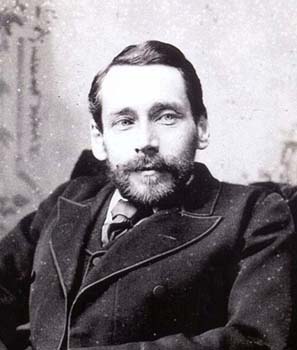
George Mercer Dawson was born in Pictou, Nova Scotia, Canada in 1849. The son of the geologist Sir John William Dawson, he began his studies at McGill University in Montreal then went to the Royal School of Mines in London, England. George Dawson is recognized as one of Canada’s pioneering geologists and conducted much of the initial geological work in British Columbia and the Yukon, where Dawson City was named after him.
One of his early contributions was his work on the Boundary Commission, which surveyed the international boundary between Canada and the United States in 1873-1875.
The summer of 1884 brought Dawson to southeast British Columbia working for the Geological Survey of Canada. By this time, Dawson was well renowned and was leading the expedition. While the presence of coal had been indicated by Michael Phillips, it was Dawson’s survey of 1884 that brought it to national attention when his work was released in 1886.
James Baker

Col. James Baker came from Kent, England in the 1880’s and soon rose to prominence as a citizen of the East Kootenays. Baker purchased a large section of land from J. Galbraith and renamed it Cranbrook after his family home in Kent.
Baker was elected to represent the East Kootenay in the Provincial Legislature and quickly became an important member of the government.
Baker spent much of his time lobbying governments and the Canadian Pacific Railway to bring a railway to the Kootenays.
As a partner in the Crowsnest Pass Coal Company and the B.C. Southern Railway, Baker stood to gain significantly from a railway through the region. In 1898, he got his wish but shortly thereafter left the Kootenays to return to his ancestral home.
Sir Willian Cornelius van Horne
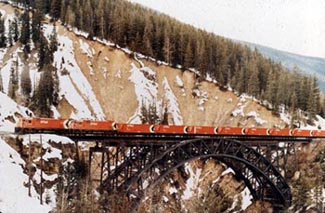
Sir William Cornelius Van Horne was the great builder of the Canadian Pacific Railway. He was in large part responsible for bypassing the Crowsnest Pass route as the mainline for the Canadian Pacific Railway in the 1880’s but used his influence as president of the CPR in the 1890’s to bring the railway through.
Van Horne speaking to the value of the Crowsnest line stated: “I firmly believe that, by the necessary efforts on the part of the Government, a greater addition can be made to the wealth of the Dominion in the next ten years ….than has been made all told in the past 30 years.”
He wasn’t wrong – the railway he championed played and continues to play an important role in mining and moving coal to markets from the Elk Valley. Today, over 20 million tonnes of coal worth over 1 billion dollars, is moved each year over the Crowsnest line.
William Fernie
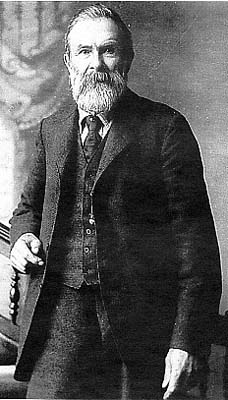
Taken from the Fernie Free Press 1901 Souvenir Edition
No sketch of Fernie would be complete without some reference to the chief promoter of this great coal enterprise, Mr. William Fernie. At the age of 14 he sailed from England on board a vessel bound for Australia as an apprentice. From thence, he went to Peru, and then to California. He soon wearied of California and 41 years ago, he came to British Columbia, where he has spent most all these years climbing these mountains exploring and surveying, until he is probably the most thoroughly posted man as to the mining and other possibilities of Southern British Columbia now living. He made his first visit to Coal creek in 1887, since which time, he has been almost constantly exploring and stripping coal seams in this vicinity, or surveying and prospecting railway lines to or from the coal fields.
He has held on to his well-earned prize through good and evil report, keeping alive his hope of final success even when friends called him a rainbow-chaser, and now wears his crown of success with the genuine modesty of a nobleman of nature. True, the jewels of his crown are black diamonds, and have not the power of magnifying light, as do the white gems of India, but they are so much more useful to his fellow man that he is amply compensated for the lack of brilliancy. No one is more deserving of success, and not one of the many who know him intimately but rejoices in it as though it were his own.
Terex Titan
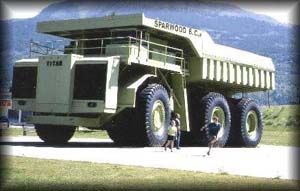
The 350 tonne Terex Titan was manufactured by General Motors of Canada. The Titan is, to date, the world’s largest tandem axle, rear-dumping hauler ever manufactured. In 1978, Kaiser Resources brought the truck to Sparwood from California to be used at its coal mine. The Titan arrived by train, on 8 rail flat cars. The truck was reassembled by the side of Highway 3 and then driven to the mine site. The Titan was powered by a 16 cylinder, 3300 horse power locomotive engine. The engine was teamed with a generator to deliver power to 4 traction motors located on the rear wheels. The generator was powerful enough to supply power to 250 modern homes.
The Titan weighs 260 tonnes and with a maximum load of 350 tonnes; it grosses at 610 tonnes. The box is capable of holding 2 Greyhound buses and 2 pick-up trucks. Tires on the truck are 11’ in diameter and one tire weighs 8000 lbs. It takes approximately 28 seconds to raise the box and 30 seconds to lower it. The Titan’s fuel tank holds 800 imperial gallons of fuel and 278 imperial gallons of oil.
In 1990, the Titan was retired – it being no longer cost efficient to operate. In the fall of 1994, Elkview Coal Corporation donated the Titan to the Sparwood Chamber of Commerce. The Chamber, with financial assistance from the District of Sparwood, Provincial Government and private donations, refurbished the truck to display standard.
The Titan project was made possible by the enthusiasm of the people of Sparwood and dedicated volunteers.
Street Art
The District of Sparwood is pleased to launch the Street Art Banner Program. This program is designed to capture the work of local artists for display on long lasting banners hung throughout the community. The Street Art Banner Program is designed to beautify the community, celebrate local artists, and preserve and celebrate local heritage through the display of art.
What is the Street Art Banner Program?
The Street Art Banner Program is designed to encourage, promote and celebrate local heritage, arts and culture through the display of artistic street banners hung on community utility poles.
The banners, which will be composed of an aluminum composite material, will allow for digitally printed artwork to be sourced from a any artistic medium.
The primary objectives of the Street Art Banner Program are:
• Beautification of the community;
• Supporting the development of local artists;
• Celebrating local artists and supporting their development;
• Preserving and celebrating local heritage through art;
• Sharing the stories of Sparwood;
• Displaying and promote the work of local artists.
Eligibility and Submission Criteria
In order to be considered by the Advisory Group, all art submissions must conform to the following.
Medium
Art may be of any medium – including photographs but must be able to be digitally reproduced and correctly scaled to the dimension of the banner.
Content
- Art must fall under the scope of heritage, environment, connection to community, and love of Sparwood.
- The use of text should be limited.
- Artwork must have a discernible, direct link to the District of Sparwood and the Elk Valley.
- Any banners containing information or displaying images that contain controversial, contentious, or provocative content or are deemed by the advisory group to be objectionable will not be eligible for selection.
Visibility
- Vivid and contrasting colors and tones are preferred. Art must be clearly visible and legible under low light or when viewed from a distance.
- Any text shown must be clearly visible from a minimum of 20 meters.
Other
- Each artist may submit a maximum of two (2) pieces for consideration. Photos of the original piece are preferred.
- All artwork must be submitted with the artists name, contact information, piece title, and brief description of the art on the Street Art Banner Program Submission Form.
- In order for selected art to be printed on banners, the art must be able to be scaled to fit a 30″ x 60″ dimension. A high quality / high resolution image must be provided or the original artwork must be made available to be photographed.
- Art submissions will be considered from any resident who resides within the Columbia Basin; however, selection preference will be given to artists residing in Sparwood or the Elk Valley.
By submitting artwork for consideration for the Street Art Banner Program, the artist warrants and represents that they are the owner of the artwork, and the artist hereby grants to the District of Sparwood the right to use the art for the designated purpose of the Street Art Banner Program. The District of Sparwood will have rights to use digital images of the art or banners in all forms of media and communications to promote the District of Sparwood.
Submissions can be forwarded to:
Jenna Jensen
District of Sparwood
Box 520, 136 Spruce Avenue
Sparwood, BC V0B 2G0
jjensen@sparwood.ca
250.425.6271
Selection Process
Street Banner Advisory Group
The Street Art Banner Program will be administered by the District through a five (5) person Street Banner Advisory Group which shall be appointed by Council annually until the Street Art Banner Program is discontinued. The Committee will be comprised of the following representatives:
- A member of the Sparwood and District Arts and Heritage Council;
- A District of Sparwood staff member;
- A member of Council;
- A Sparwood senior representative; and
- A Sparwood youth representative.
Selection Criteria
The Advisory Group will use the following criteria when evaluating art submissions:
- Submissions will be evaluated without names;
- All submission criteria and eligibility requirements are met;
- Creativity, originality, and overall impression of the art;
- The relevance and likely appeal to the community audience;
- The ability of the art to enhance the beauty of the community;
- The quality of the artwork submitted.
Award
Once the Advisory Group has evaluated the submissions, they will provide Council with their recommendations on artwork to be reproduced and used in the Street Art Banner Program. Council will then review the recommendations and award the successful art submissions. All artists will be notified of Council’s decision, and artists will receive a $500 honorarium for artwork that is selected for production into a street banner.
Artist Biographies
Kally Campbell
Kally Campbell is currently a grade 12 student attending Sparwood Secondary School. She has been an avid art student throughout her years in school. Kally’s paintings primarily portrays her love for the outdoor environment that she is so grateful to have grown up in. Many of her pieces are inspired by the mountainous scenery of the Elk Valley, as well as by the places she has travelled to around the world. Kally’s favourite mediums to work with are acrylics and watercolours, however, she is interested in exploring more with oil paints in the future. Some of Kally’s other interests include playing volleyball, basketball and hiking.
Alysha Clark
Alysha Clarke is a BCRMT, mother, wife and painter. She has lived in the Elk Valley for the last 28 years. During that time, she has pursued her hobby as a painter. She loved to take classes at the Arts Station when they were offered, but mostly just painted at home for her own enjoyment.
Alysha has dedicated a majority of her time over the past 17 years to growing her massage therapy clinic and raising three daughters. She recently decided to spend more time painting again, which has resulted in a few art shows at local galleries, allowing her to present her work to the community. Alysha enjoys working with acrylic, oil and alcohol inks.
Ashley Decker
Ashley Decker is a self-taught artist, who has been creating since day one. Her love of painting with acrylics was explored at the age of seventeen – when she really began her journey of self-healing.
Seventeen years later, her work has grown along with her. Acrylic paints, mediums, dried wild flowers, drift wood and anything she can get her hands on in nature expresses her whimsical, and soulful style which share some of the adventures had in her own back yard – Sparwood, British Columbia.
You will find delicious landscapes, curious foxes and wildlife, personalized pet portraits, and anything her heart composes.
Sue Hanlon
My name is Sue Hanlon and I’m a local Artist from Sparwood BC. I have lived in and been inspired by the elk valley for the last 30 years.
My formal art training came through the university of Lethbridge followed by and education degree from the university of Calgary. Upon moving to Sparwood, I taught art at the local high school as well as evening and weekend workshops for those aspiring to create their own art. I took time off to raise three kids with my husband Bill. I moved into mural painting and have been given some great opportunities to paint murals in the valley at schools, public meeting places and private homes.
Creating art became a social event in the cities so I recognized the opportunity to bring “paint nights” to the valley. These are fun, social evenings where people come out with their friends and are lead step by step through a two hour beginner painting – A great way to encourage new painters to try out their creative bends!
The best is still coming though as I wind down my teaching career and start to concentrate on my personal art career. I so look forward to taking my art to a new level and just “enjoying the process” as I tell my new artists!
So when I saw the banner program I hopped right in and am so thankful to the district of Sparwood for providing such an opportunity and backdrop for local artists/art.
Dani Holmgren
I’m Dani. I’ve worked in the beautiful industry of body art for about seven years now and there are definitely still tines I can’t believe I’ve fallen into this career, and I’m only just beginning.
I’ve always found art has come somewhat easy to me. I suppose growing up in lil’ ole Elko my only options were build forts, ride bikes and draw. Wait…that’s what I still do.
I first moved to Sparwood nine years ago, moved around a bit, but couldn’t keep myself away. I am absolutely proud to call the 425 home.
The past couple of years I have gotten back into painting more than ever before, but I still have lots of growing to do (that was a short joke.) I feel thankful for my painting to even be considered.
“There you go again Sparwood, making me a better person.” – CK
FB: Tattoos By Dani
IG: @tattoos.by.dani
Karen MacDonald
Karen MacDonald is a self-taught, multidisciplinary artist, who strives to stretch creative boundaries by applying mixed media combinations and discover what they will do together.
Originally from Regina, Saskatchewan, Karen has always been creative. It wasn’t until moving to Fernie that she was able to explore her artistic side. Whether working on her own, or with the Fernie Visual Artists, she has been able to continue to experiment and develop her style.
Online learning has increased her curiosity and the need to explore.
Karen is driven to create whimsical, offbeat imagery, with a quirky, playful sense of humour that adds a sense of delight and joy in her pieces.
Follow her process @imagingsbykaren on Instagram.
Jolene Miner
Jolene Miner creates with delicious candy colors, vibrant patterns and rich textures, and her work tends to have a playful dreamlike quality. A graduate of the University of Saskatchewan’s Fine Arts program, Jolene creates in her home studio using a variety of mediums. She finds pleasure in painting and drawing but favors creating whimsical collages with handmade and Japanese papers. Each piece is an exploration of simplicity, playfulness and freehand cutting. She finds inspiration in nature, music and the colorful world inside her head

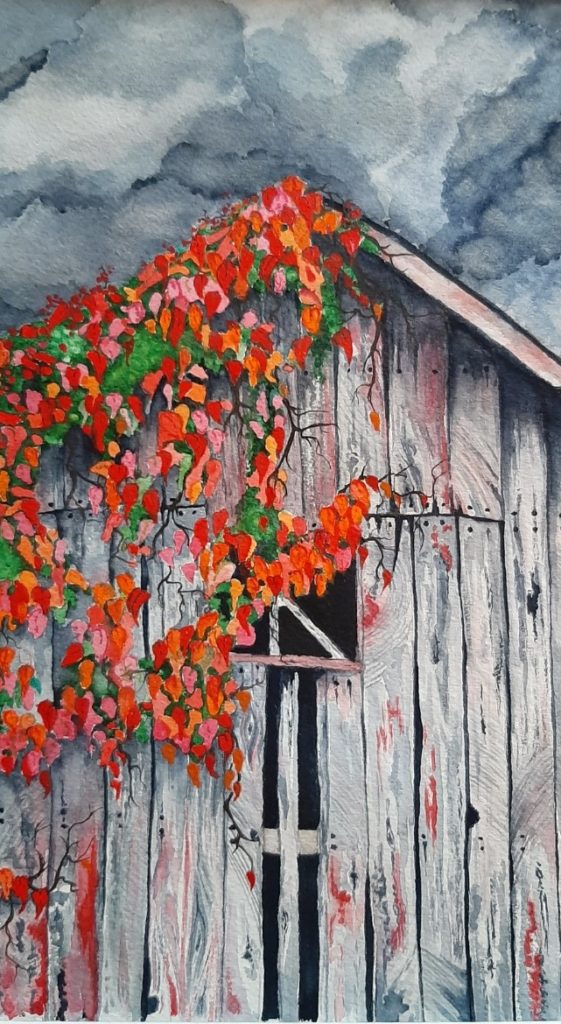
Grace Von Matt
Grace von Matt, born in Nelson BC, has been a resident of Sparwood B.C. for almost 50 years. Counting herself lucky to have been raised in the beautiful Elk Valley, she met her husband and raised their daughter here. She dabbled in many artistic forms – starting with pencil sketching at an early age to trying different mediums in high school art, then, as an adult became interested in painting with acrylics. This led the self guided artist to try her hand at stained glass for a time. Later she became challenged by a new medium when invited to join a watercolour art group of exceptional ladies from Sparwood! Through mentorship, constructive critiques, failed attempts and many a laugh she found a love for the beautiful intricacies of watercolour. Still learning and growing in the art form, she has recently added soft pastel paintings to her repertoire and occasionally mixes the two. Always learning and loving to create, she illustrated a children’s book
“Finding the Griz” for a local author. At this time, Grace is feeling more confident about her creations and has started sharing her artwork to the delight of family, friends and strangers alike.
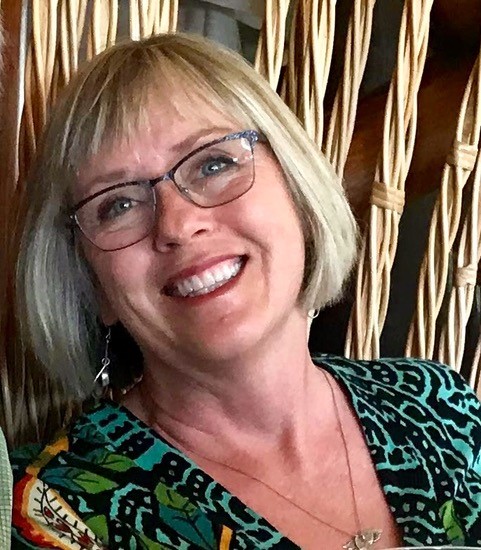
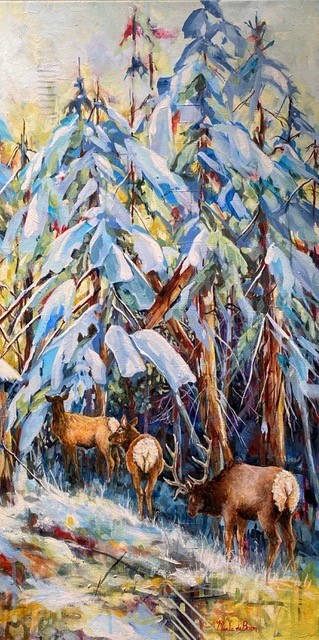
Marla deBoon
Like many people, Marla deBoon has always been creative and
imaginative. She was first attracted to the romance of the
images portrayed by western artists. Her life of horses, rodeos,
cattle drives and beautiful landscapes became major influences
in her creative pursuits. The exploration of watercolours and
acrylics soon followed. After moving to Fernie in 1988, her life
interests changed in the spectacular Rocky Mountains, and
artistic shifts occurred. Now, Marla finds herself integrating
techniques in an eclectic way, letting her intuition drive the
approaches used, giving each painting individuality.
Abryanna Storey
Abryanna Elisabeth-May Storey is a self-directed artist who is 17 years of age, and a grade twelve student at Sparwood Secondary. She was born in Creston, British Columbia, and moved to Elk Valley with her family when she was thirteen. She has always loved art. From music to painting to drawing, she has used her artistic skills to create some wonderful works. She hopes to go on to become a high school art teacher, with her love of children and helping others along her side. Others have said she is a “bright, outgoing, bubbly spirit” who wants to go on to spread the world with positivity and help others as she goes along.
Time Capsule
On March 19, 2024 the Time Capsule was opened, forty years after it was placed inside the Greenwood Mall in Sparwood, BC. Below you will find the contents within. Items will also be on display at the Sparwood Museum.
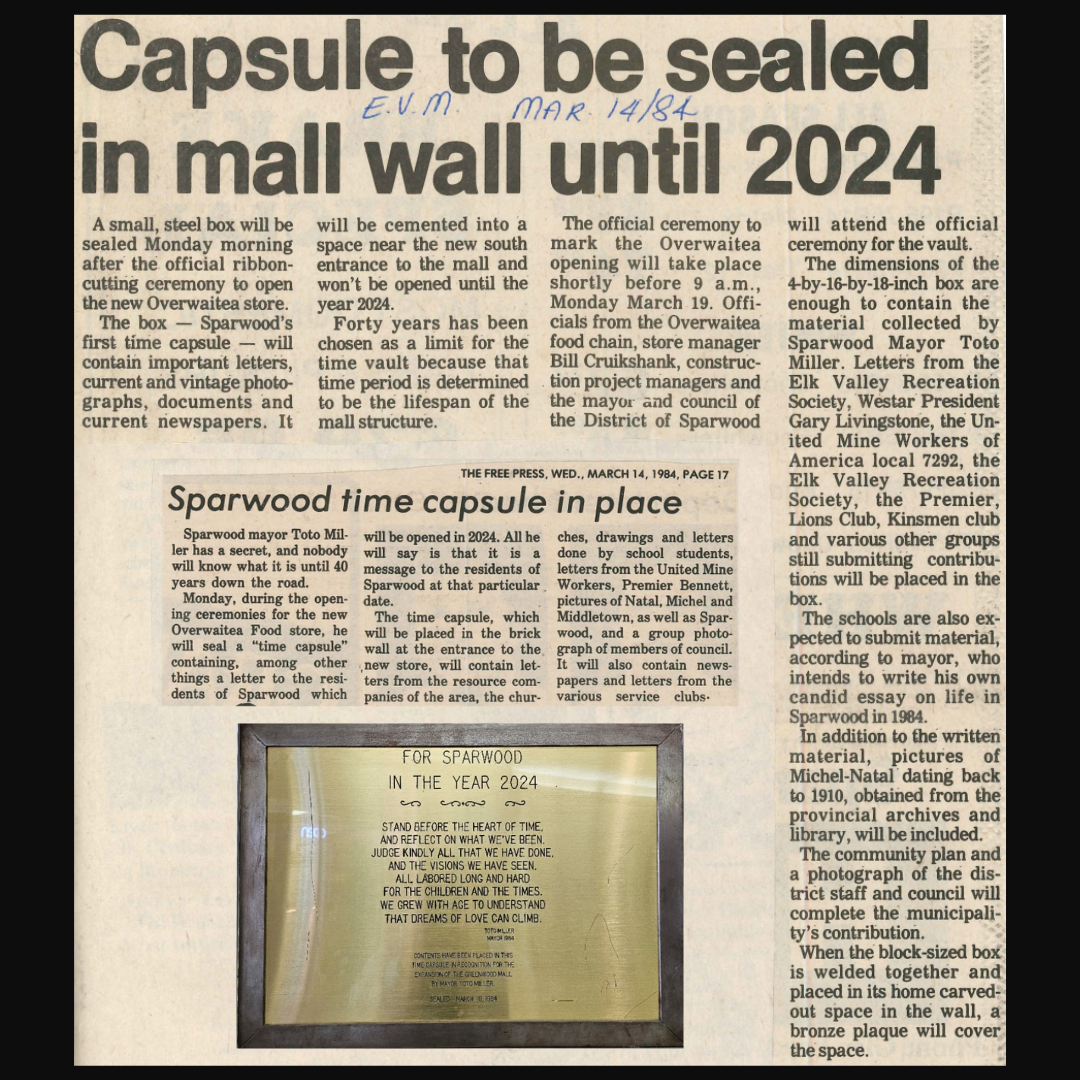
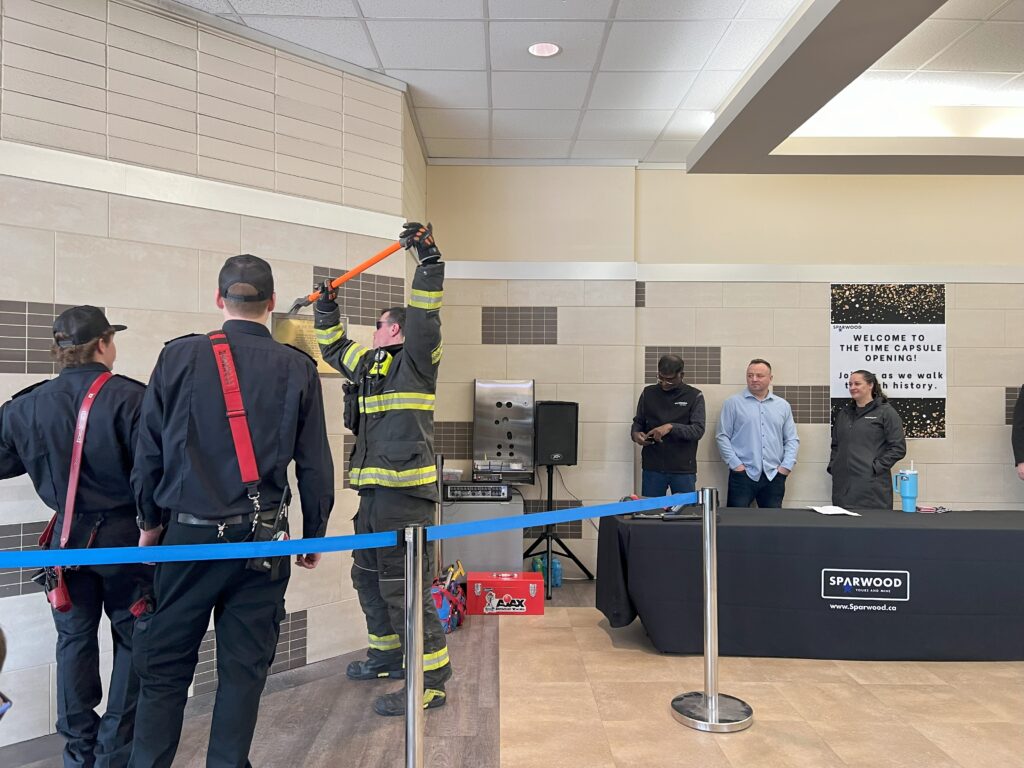
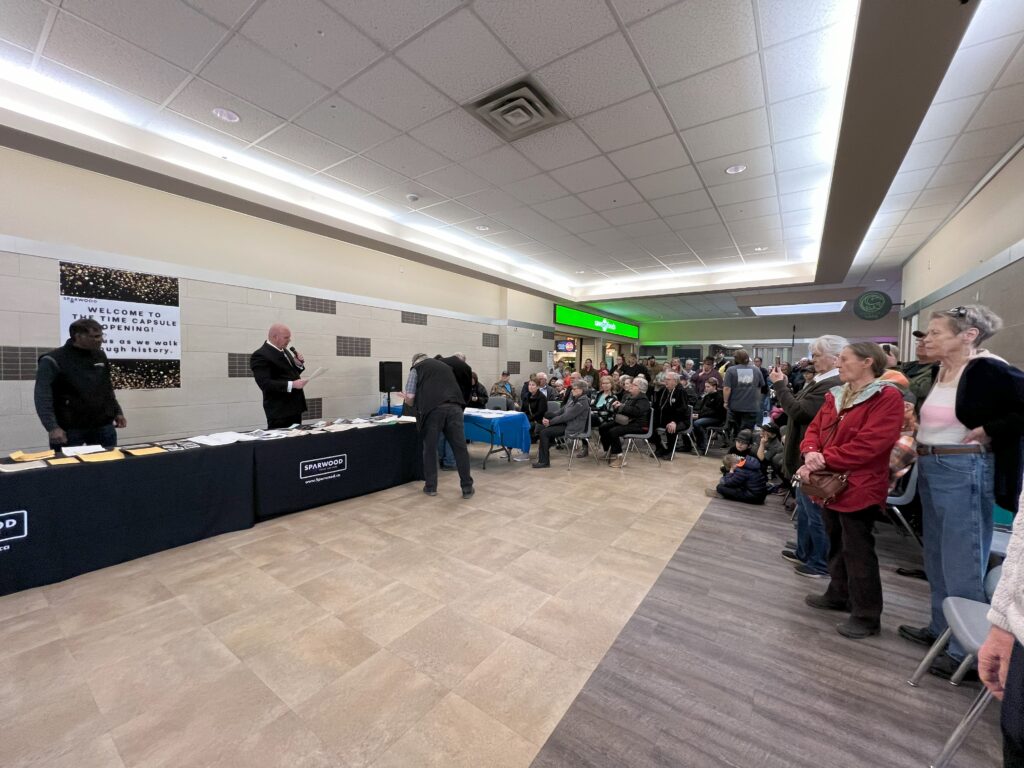
Article – The Best of Our Past Moments
Article – Southeast Coal Continues to Slog it Out – Toto Miller
Brochure – Crowsnest Resources
Brochure – Mining Association of British Columbia
Brochure – Regional District of East Kootenay
Brochure – Westar Mining Balmer Operations
Brochure – Westar Mining Transportation
Brochure – Westar Mining Corporation
Document – Collective Agreement
Document – Concept Design for Greenwood Mall
Document – Girl Guides
Document – Hospital Employees Union
Document – Library Annual Report
Document – List from Charter
Document – Michel Local Union 7292
Document – Province of BC Budget
Document – Sparwood Lady Lions Club
Document – Sparwood Lions Club
Document – Westar Fact Sheet
Document – Figure Skating Club
Drawings – Frank J Mitchell Elementary School
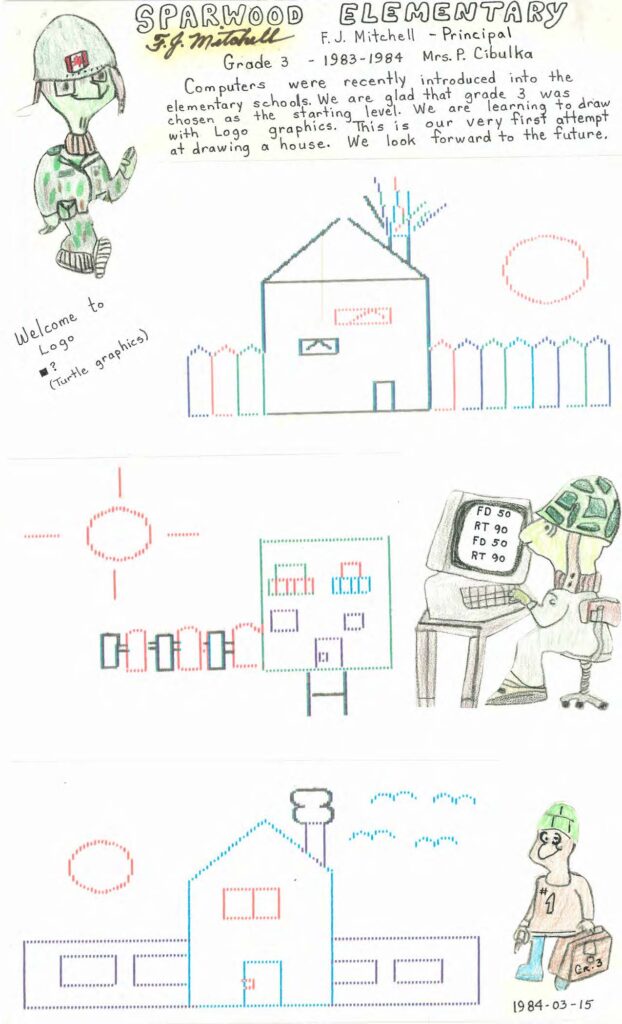
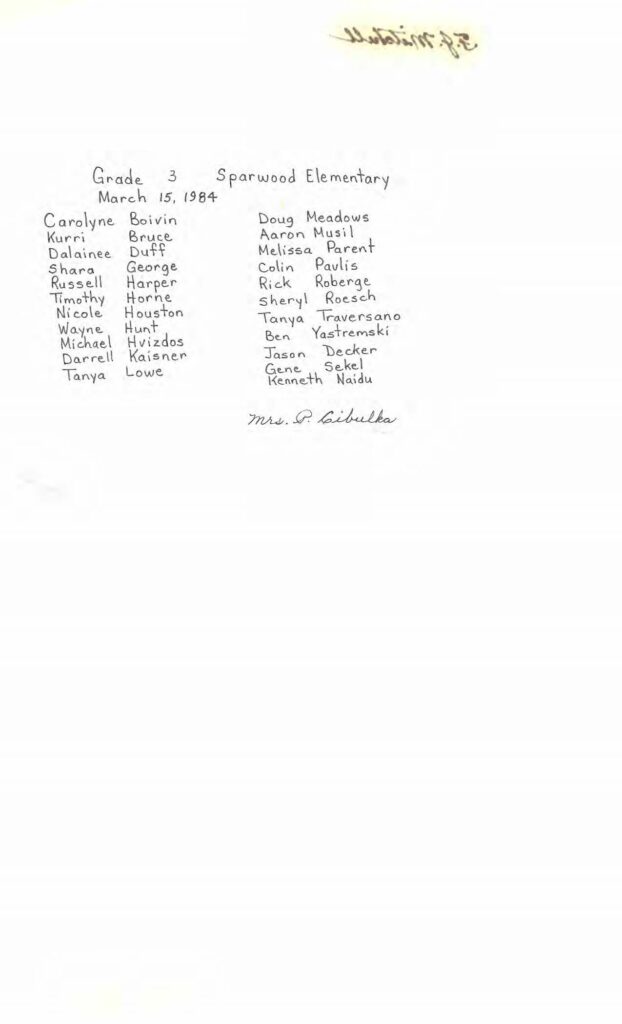
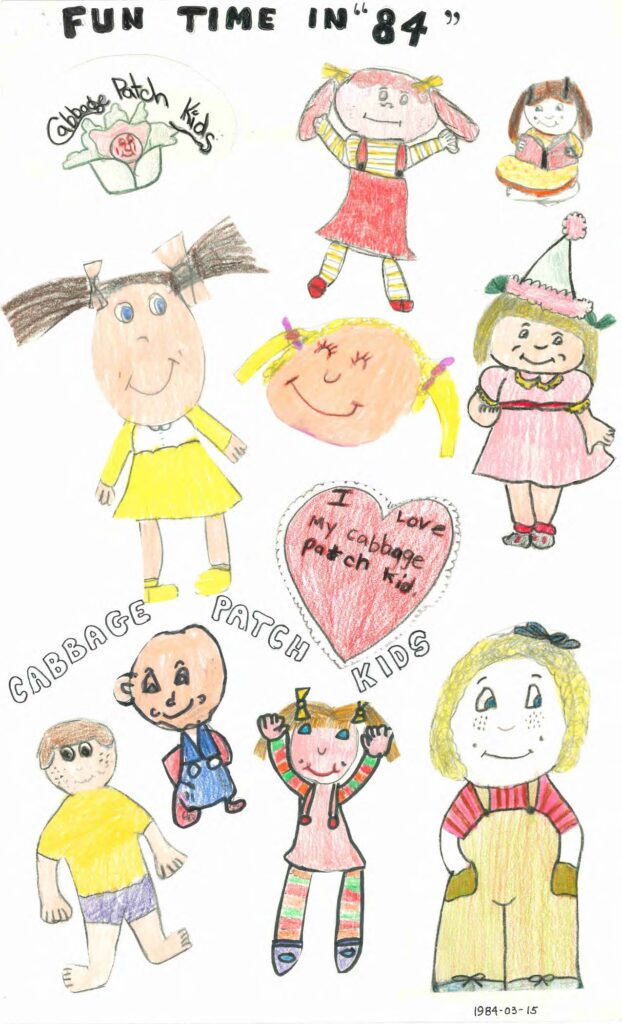
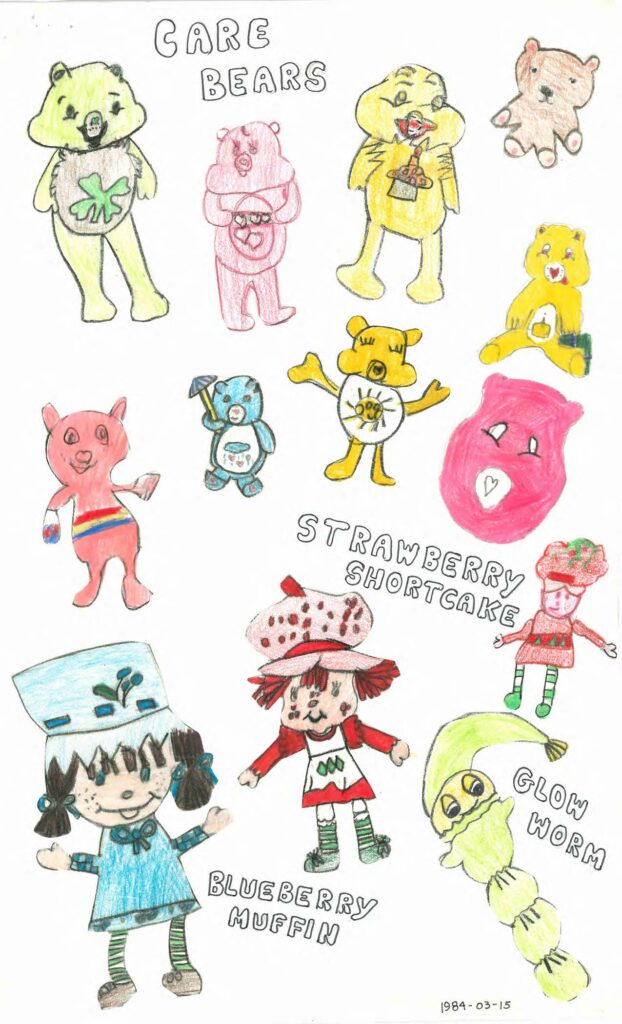

Drawings – Mountain View Elementary School











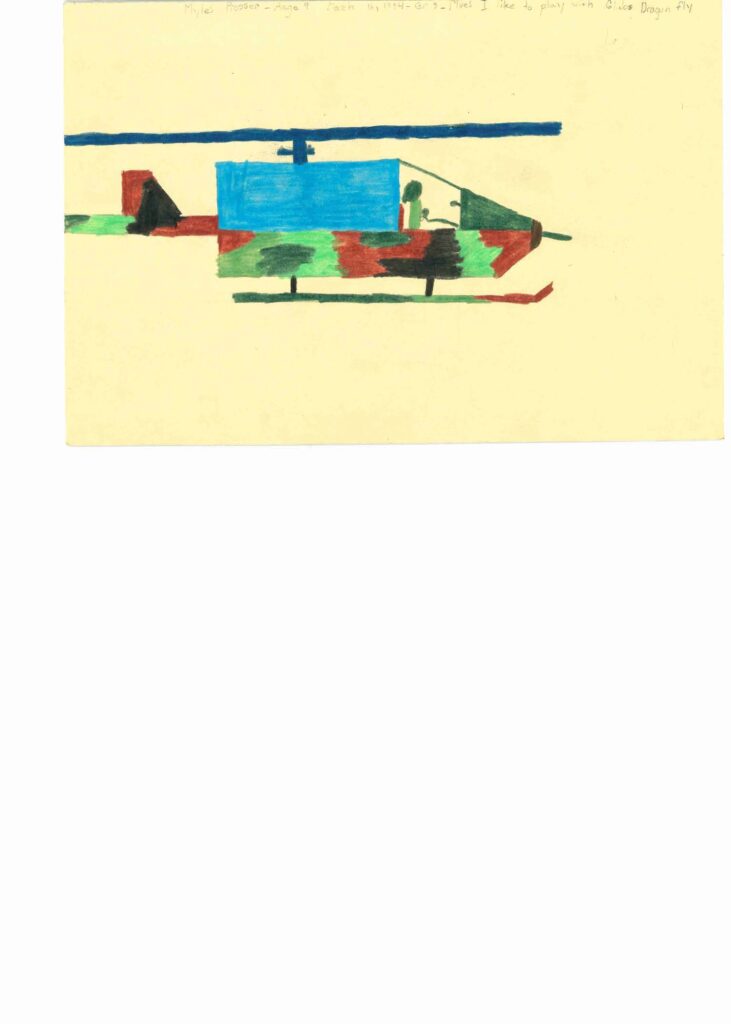

Letter – 1st Sparwood Beavers
Letter – 1st Sparwood Scouting Group Committee
Letter – 1st Sparwood Wolf Pack
Letter – Alfred Obray, Mall Merchants Association
Letter – Elk Valley Recreation Society
Letter – Kinette Club of Sparwood
Letter – Mayor to Lyle Patrick
Letter – Mountain View Elementary Grade 3
Letter – Sparwood Community Development Society
Letter – Sparwood Library
Letter – Sparwood Lutheran
Letter – Jehovah’s Witness
Letter – Rotary Club of Sparwood
Letter – St. Barbara’s Anglican Church
Letter – Westar Mining to Mayor
Letter – Mayor Toto Miller
Magazine – Sparwood Today – Autumn 1983
Magazine – Elk Valley Coal Producers
Magazine – Sparwood, BC – Building Beyond Tomorrow
Magazine – Sparwood, The Clean Coal Capital of Canada
Maps – Sparwood, BC
Newsletter – The Coal Express, Balmer Employees
Newspaper – Crowsnest Clarion – Feb 13
Newspaper – Crowsnest Clarion – Feb 20
Newspaper – Crowsnest Clarion – Feb 27
Newspaper – Crowsnest Clarion – Mar 12
Newspaper – Elk Valley Miner
Newspaper – Overwaitea Grand Opening
Newspaper – Westar Mining Energy Line
Photos
